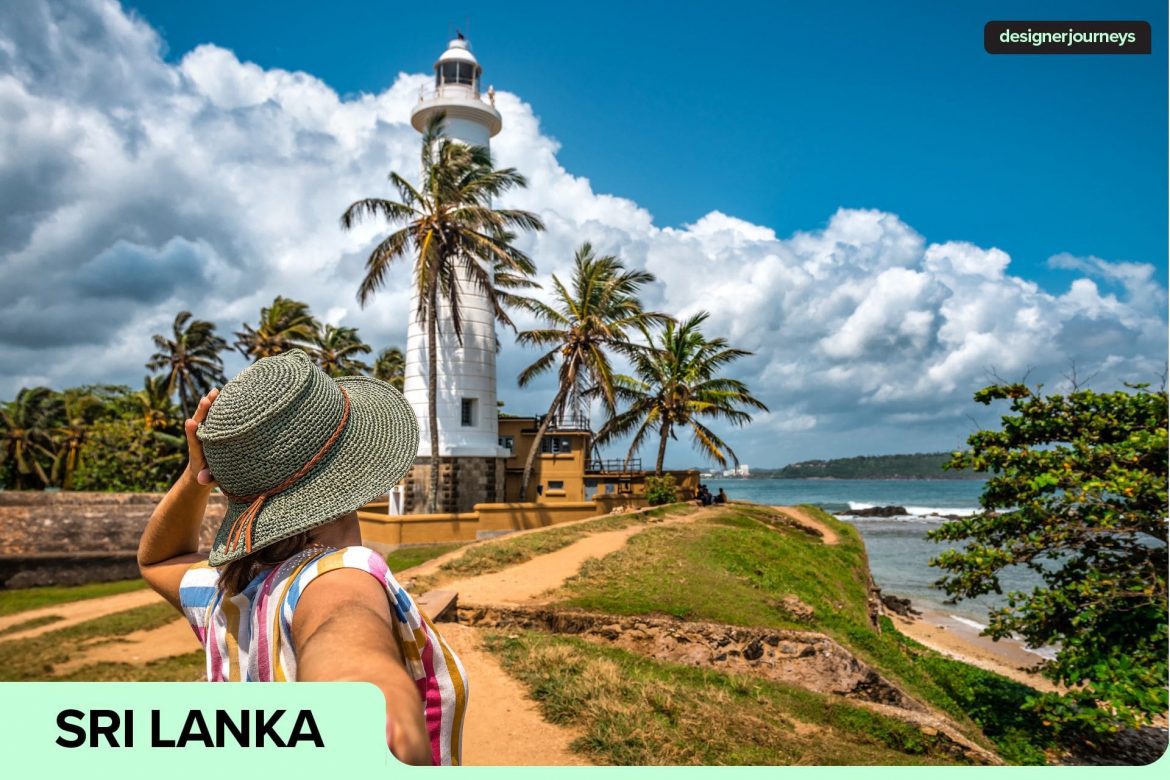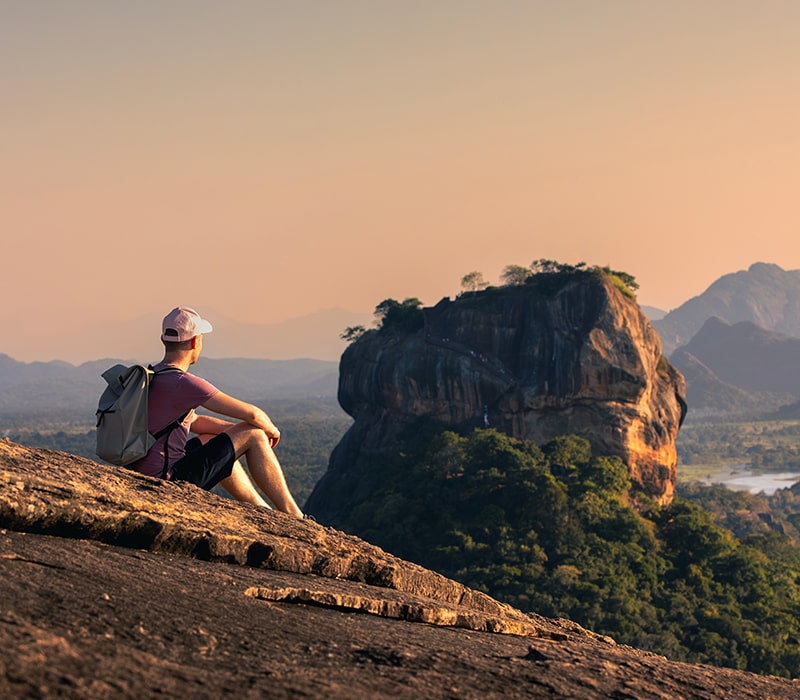Sri Lanka, the teardrop-shaped island nation nestled in the Indian Ocean, beckons travellers with its extraordinary diversity packed into a compact landmass. This enchanting destination offers an unparalleled blend of ancient history, stunning natural beauty, vibrant culture, and warm hospitality that makes it perfect for both first-time visitors and seasoned explorers. Designer Journeys will take you through a carefully crafted three-week journey across this remarkable island nation, ensuring you experience the very best of what Sri Lanka has to offer. Whether you’re drawn to ancient ruins, wildlife encounters, scenic train rides, or simply relaxing on stunning beaches, this Sri Lanka itinerary covers it all.
Post Contents
- Planning Your Sri Lanka Itinerary
- Week 1: Cultural Triangle and Hill Country
- Week 2: Wildlife and Ancient Wonders
- Week 3: Beaches and Coastal Adventures
- Northern Sri Lanka: Extended Adventure Options
- Wildlife and Nature Beyond the Classics
- East Coast Adventures
- Tea Country Deep Dive
- Practical Tips for Your Sri Lanka Adventure
Planning Your Sri Lanka Itinerary
Best Time to Visit Sri Lanka
Understanding Sri Lanka’s climate patterns is crucial for planning your trip. The island experiences two main monsoon seasons, but these affect different regions at different times, meaning there’s always somewhere pleasant to visit.
For the western and southern coasts, including Colombo City, Galle, and Mirissa, the best time to visit is from December to March, when the weather is dry and sunny. The hill country, including Kandy, the Ella train journey, and Nuwara Eliya, experiences its driest period from December to April, making this the ideal time for scenic train rides and visits to tea plantations.
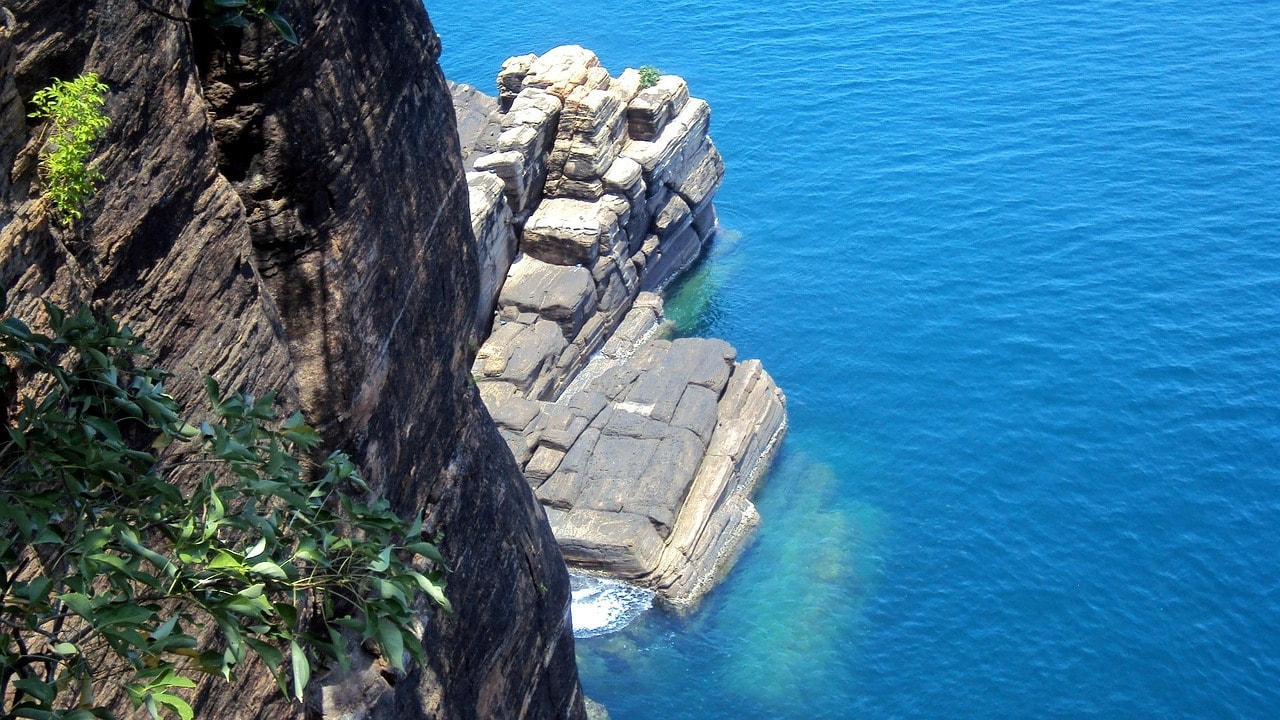
A short boat ride from Nilaveli Beach, this marine national park is a paradise for snorkeling and diving.
The east coast, including Trincomalee and Arugam Bay, enjoys its best weather from April to September, opposite to the west coast. The northern regions, including Jaffna and Anuradhapura, are most pleasant from February to September.
For the best overall weather across the island, consider visiting during the shoulder seasons of March to April or October to November. These periods offer pleasant temperatures, minimal rainfall, and excellent conditions for both beach activities and wildlife safaris.
Are you planning a trip to Sri Lanka?
Browse our gallery of fully customisable Sri Lanka itineraries and connect with one of our expert Local Designers to get you started! Designer Journeys can design your ultimate experience and offers hand-crafted itineraries built by experienced Local Designers who have first-hand knowledge of the destination.
Getting to Sri Lanka
Most international visitors arrive at Bandaranaike International Airport (CMB), located approximately 35 kilometres north of Colombo. The airport, also known as Colombo International Airport, serves as the primary gateway to the island and handles flights from major cities across Asia, Europe, and the Middle East.
Sri Lankan Airlines, the national carrier, operates from a modern hub at Bandaranaike International Airport and connects the island to destinations worldwide. The airline offers direct flights from major cities including London, Dubai, Singapore, and Delhi. Many international airlines, including Emirates, Qatar Airways, and Singapore Airlines, also offer competitive routes with convenient connections.
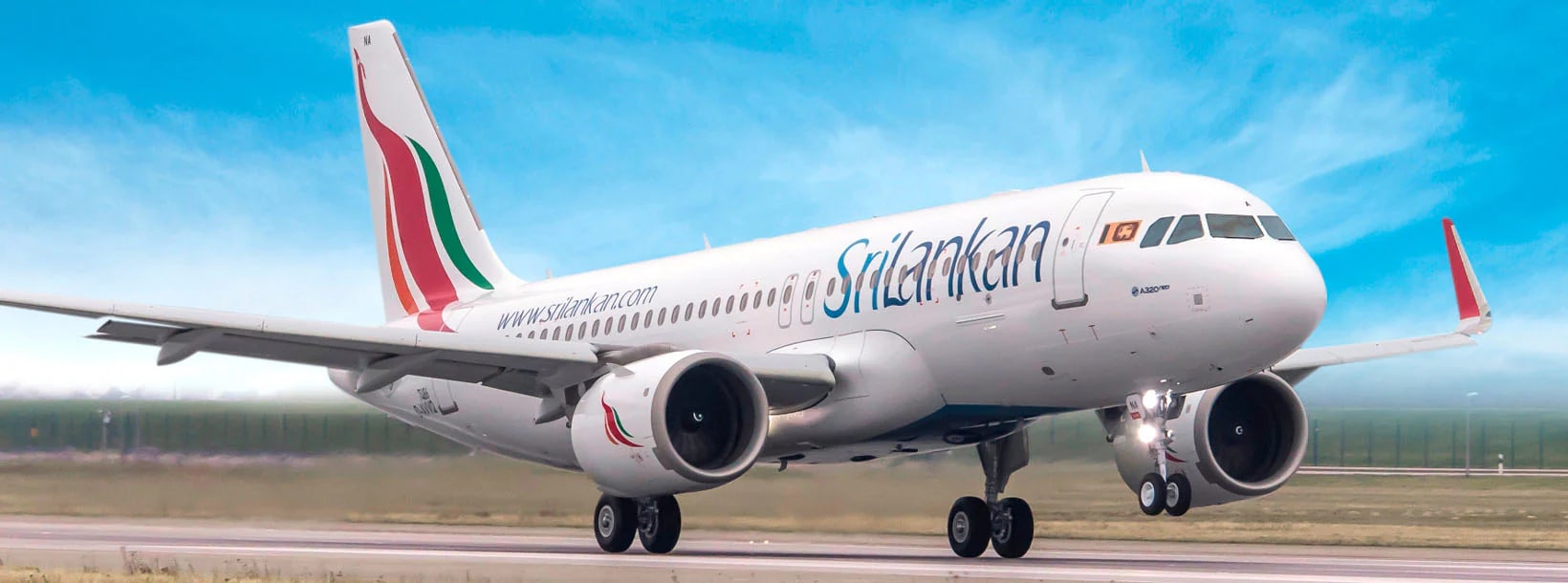
The airport serves over 10.79 million annual passengers.
The airport features modern facilities including duty-free shopping, restaurants, and comfortable lounges. Currency exchange services are available, though ATMs throughout the country offer competitive exchange rates. Pre-arranged airport transfers can be booked through hotels or tour operators, whilst taxi services and ride-sharing apps provide convenient transportation to your first destination.
Visa Requirements and Entry
Most visitors to Sri Lanka require a visa, which can be obtained online through the Electronic Travel Authorisation (ETA) system or on arrival at the airport. The ETA system allows tourists to apply for a 30-day visa online before travel, making the arrival process smoother.
Citizens of Singapore and the Maldives can enter Sri Lanka without a visa for up to 30 days. Other nationalities should check current visa requirements as these can change. Your passport must be valid for at least six months from your date of arrival.
Currency and Money Matters
The Sri Lankan Rupee (LKR) is the local currency, with notes available in denominations of 20, 50, 100, 200, 500, 1,000, 2,000, and 5,000 rupees. Coins are available in denominations of 1, 2, 5, and 10 rupees.
ATMs are widely available in major cities and tourist areas, accepting international cards from major networks. Most ATMs dispense notes in multiple denominations, and withdrawal limits are generally generous. Credit cards are widely accepted at hotels, restaurants, and shops in tourist areas, but cash remains essential for smaller establishments, local transportation, and rural areas.
It’s advisable to carry some cash in small denominations for tips, local transport, and small purchases. US dollars and euros can be exchanged at banks, authorised money changers, and hotels, though rates may vary.
Week 1: Cultural Triangle and Hill Country
Day 1-2: Colombo – Gateway to the Island
Begin your Sri Lankan adventure in the vibrant capital city, where colonial architecture meets modern development. Colombo offers an excellent introduction to Sri Lankan culture, cuisine, and the rhythm of everyday life that characterises this island nation.
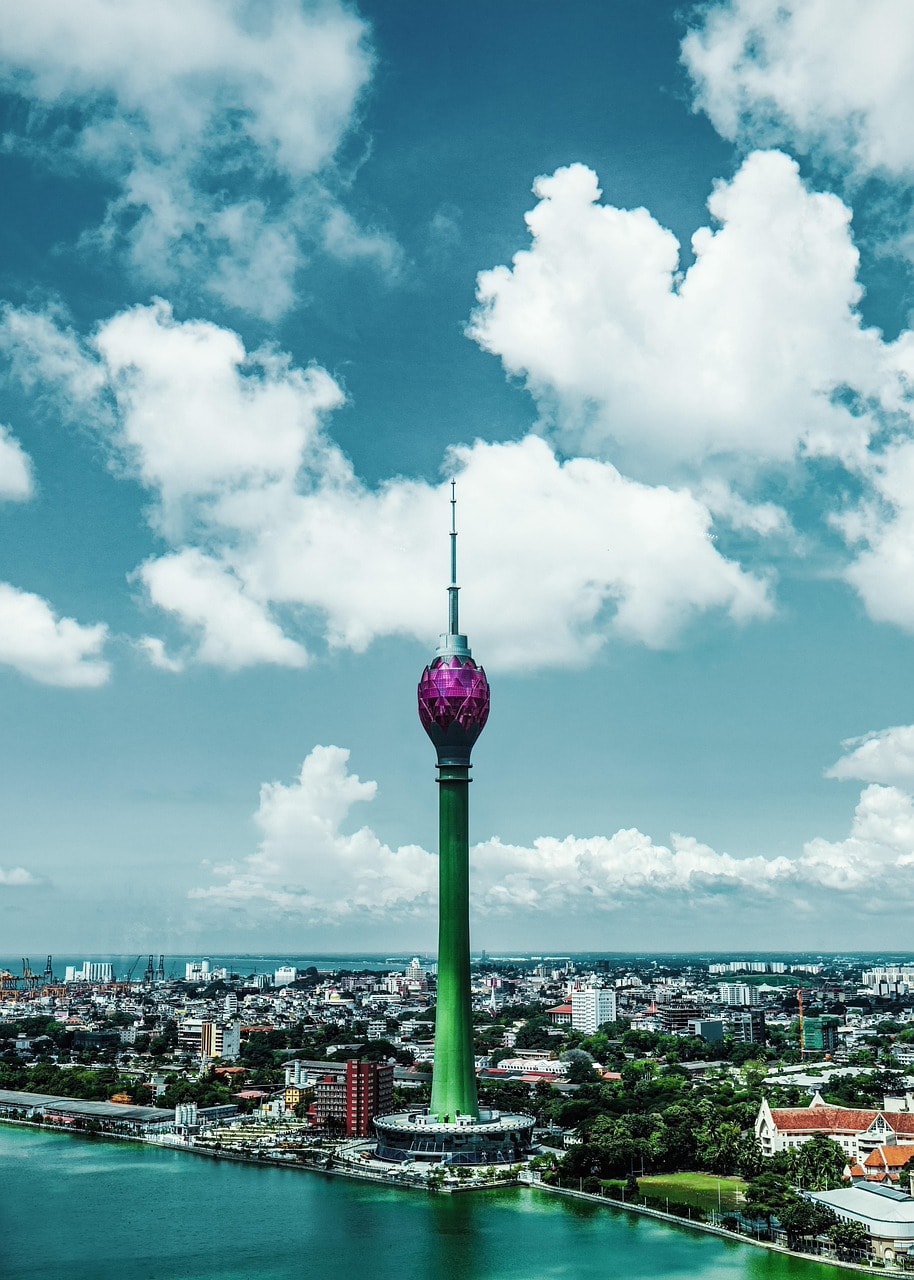
A vibrant and chaotic open-air market known for its diverse range of goods.
Start your exploration early at the bustling Pettah Market, where the sensory overload of colours, sounds, and aromas provides an authentic taste of local life. The market’s narrow lanes are filled with vendors selling everything from fresh spices and tropical fruits to textiles and electronics. The nearby Red Mosque, with its distinctive Indo-Saracenic architecture, stands as a testament to the city’s multicultural heritage.
The Dutch Hospital Shopping Precinct, a beautifully restored colonial building, now houses boutique shops, cafes, and restaurants. The contrast between the historic architecture and modern commercial activity perfectly encapsulates Colombo’s blend of old and new.
Visit the National Museum, housed in a grand colonial building, to understand Sri Lanka’s rich history from ancient times to the present. The museum’s collection includes royal regalia, ancient manuscripts, and artifacts from various periods of the island’s history. The natural history section provides insights into Sri Lanka’s unique biodiversity.
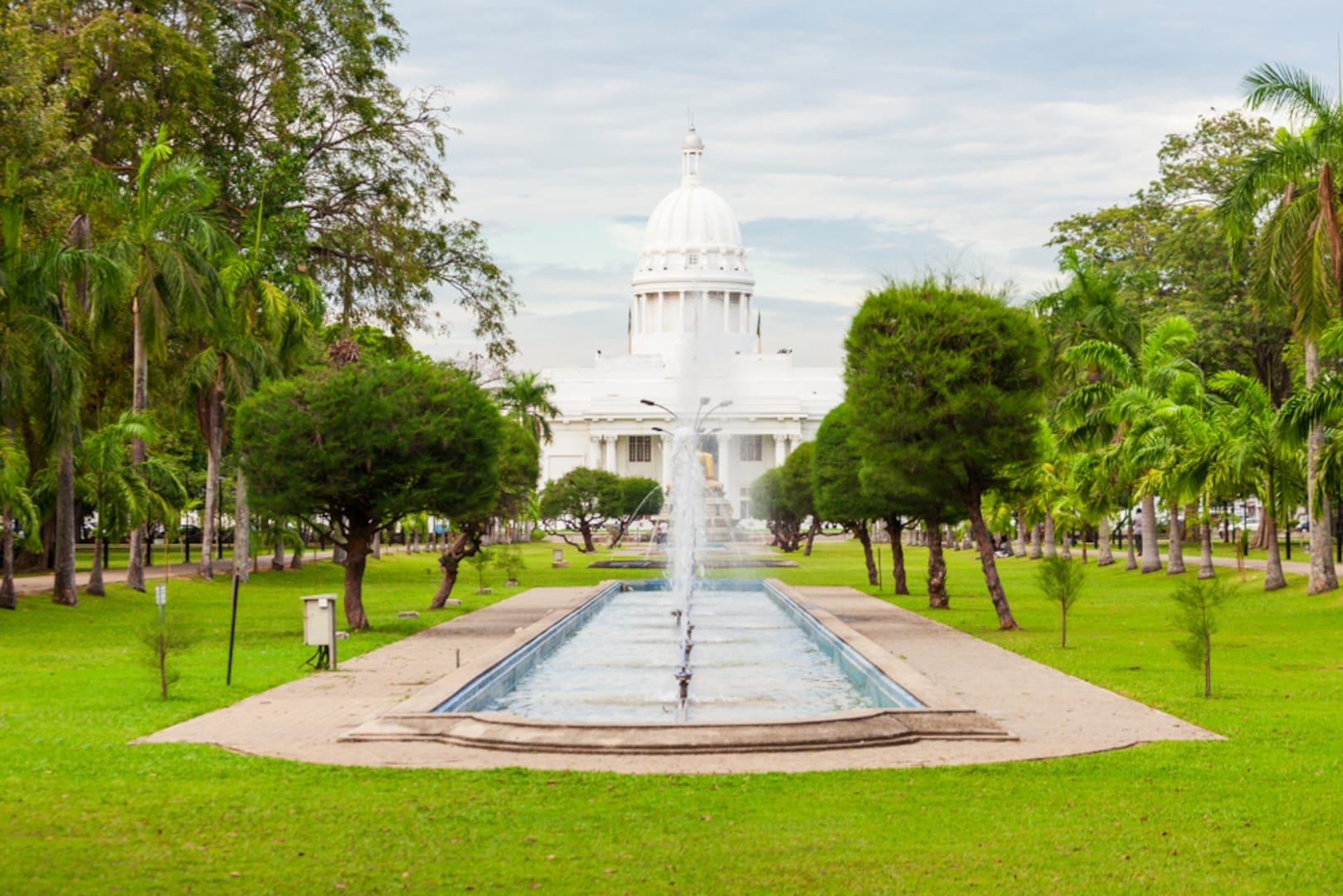
There is a scenic artificial lake where visitors can enjoy paddle boating or boat rides.
Take a leisurely stroll through Viharamahadevi Park, Colombo’s largest park, which offers a peaceful respite from the city’s hustle and bustle. The park’s large trees, including magnificent rain trees and palm trees, provide shade for picnicking families and couples. The park frequently hosts cultural events and festivals, providing visitors with an opportunity to experience local traditions.
The Gangaramaya Temple, one of Colombo’s most significant Buddhist temples, provides insight into the island’s rich spiritual traditions. The temple complex features a museum, library, and vocational training centre, showcasing Buddhism’s contributions to education and social welfare. The evening puja ceremony provides a moving introduction to Buddhist practices.
For accommodation, consider staying in the Fort area, which offers historic charm and easy access to major attractions. The Cinnamon Gardens area offers upscale options, featuring excellent restaurants that serve both international cuisine and authentic Sri Lankan dishes. The Galle Face Green area offers beachfront hotels with stunning sunset views over the Indian Ocean.
Don’t miss the opportunity to sample Sri Lankan street food at Galle Face Green, where vendors sell everything from isso vadai (prawn fritters) to fresh coconut water. The evening atmosphere here is magical, with families gathering to watch the sunset and fly kites in the ocean breeze.
Day 3-4: Kandy – The Cultural Heart
Travel to Kandy, the former royal capital and spiritual centre of Sri Lanka. The journey takes approximately three hours by road through increasingly rural landscapes, offering glimpses of village life, rice paddies, and roadside fruit stalls selling tropical delicacies.
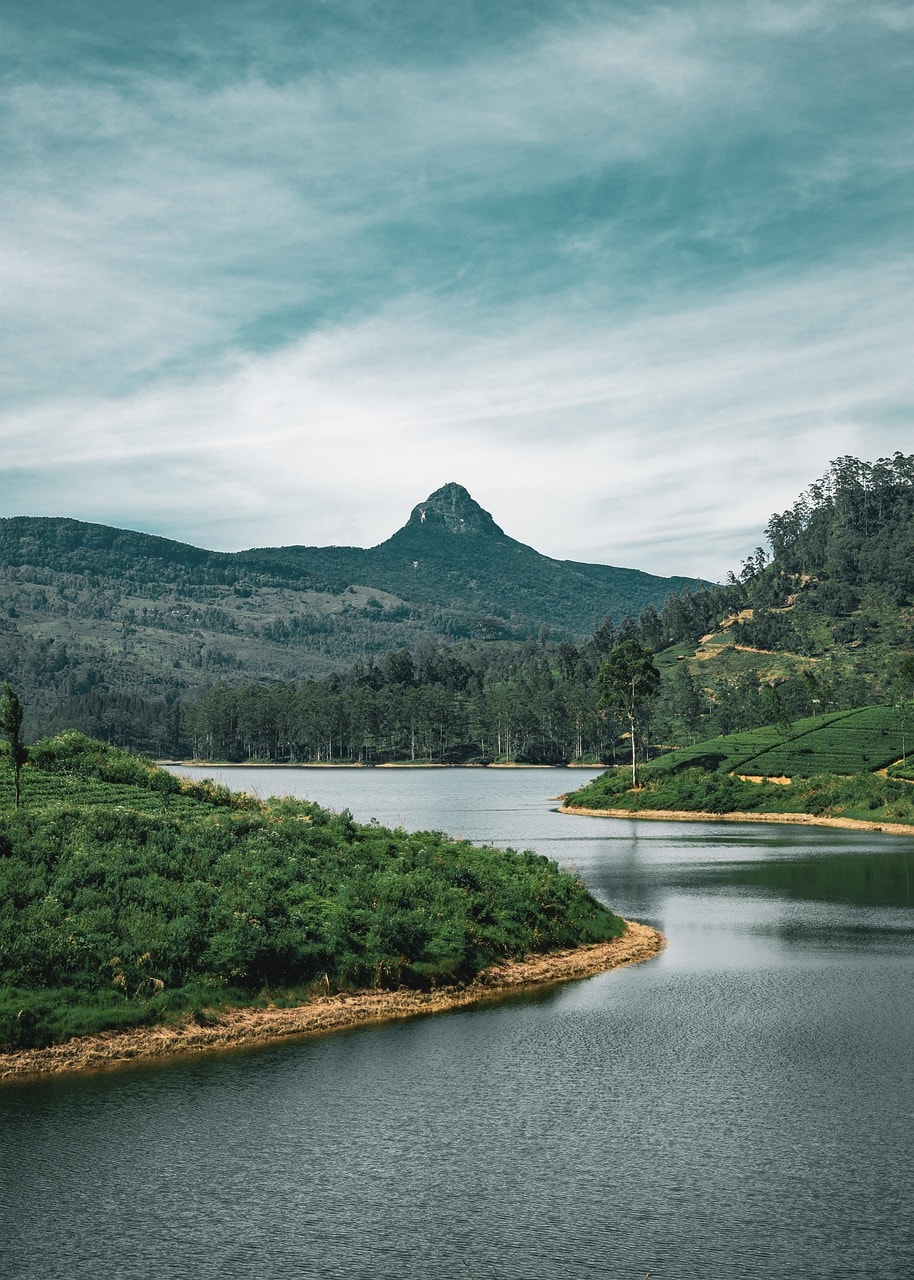
This scenic artificial lake lies serenely beside the Temple of the Sacred Tooth Relic.
Kandy, nestled in the hills of central Sri Lanka, revolves around the sacred Temple of the Tooth Relic (Sri Dalada Maligawa), which houses one of Buddhism’s most revered relics. The temple complex, built during the 17th and 18th centuries, showcases traditional Kandyan architecture with its distinctive roofs and intricate woodwork.
The evening puja ceremony at the Temple of the Tooth provides a deeply moving Sri Lankan experience. Devotees from around the world gather to pay their respects, creating an atmosphere of reverence and devotion. The ceremony involves traditional drumming, chanting, and the opening of the shrine containing the sacred relic.
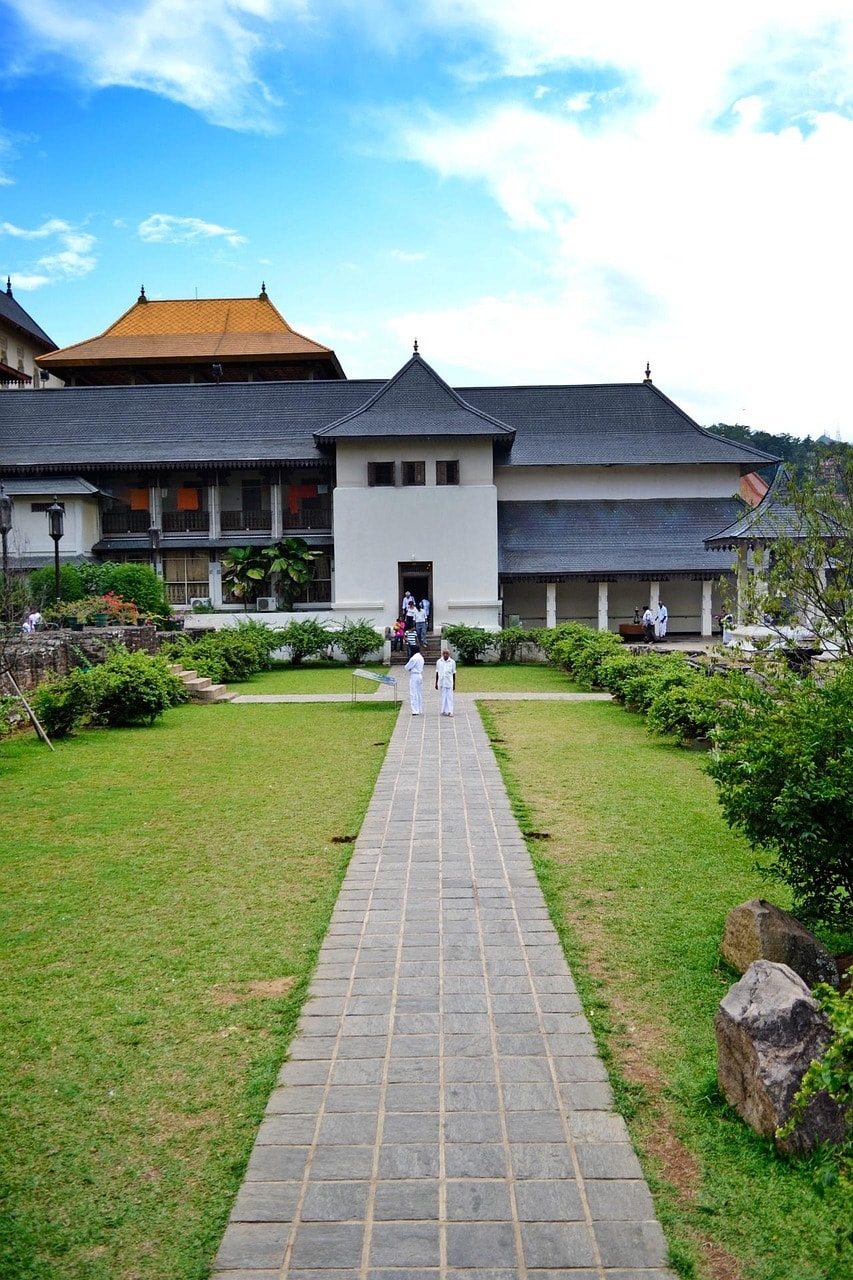
Kandy’s biggest festival, held annually in August, is a spectacular procession of painted elephants.
Explore the Royal Botanical Gardens in Peradeniya, located just outside Kandy. These gardens, established in 1843, house over 4,000 plant species spread across 147 acres. The orchid house contains one of the world’s finest collections of orchids, whilst the palm avenue features towering specimens from around the tropics. The gardens’ peaceful pathways wind past medicinal plants, spice gardens, and rare endemic species.
The gardens also house the famous cannonball tree, whose unusual spherical fruits and fragrant flowers attract visitors from around the world. A large collection of bamboo species creates natural tunnels and walkways, whilst the suspension bridge over the Mahaweli River offers scenic views of the surrounding landscape.
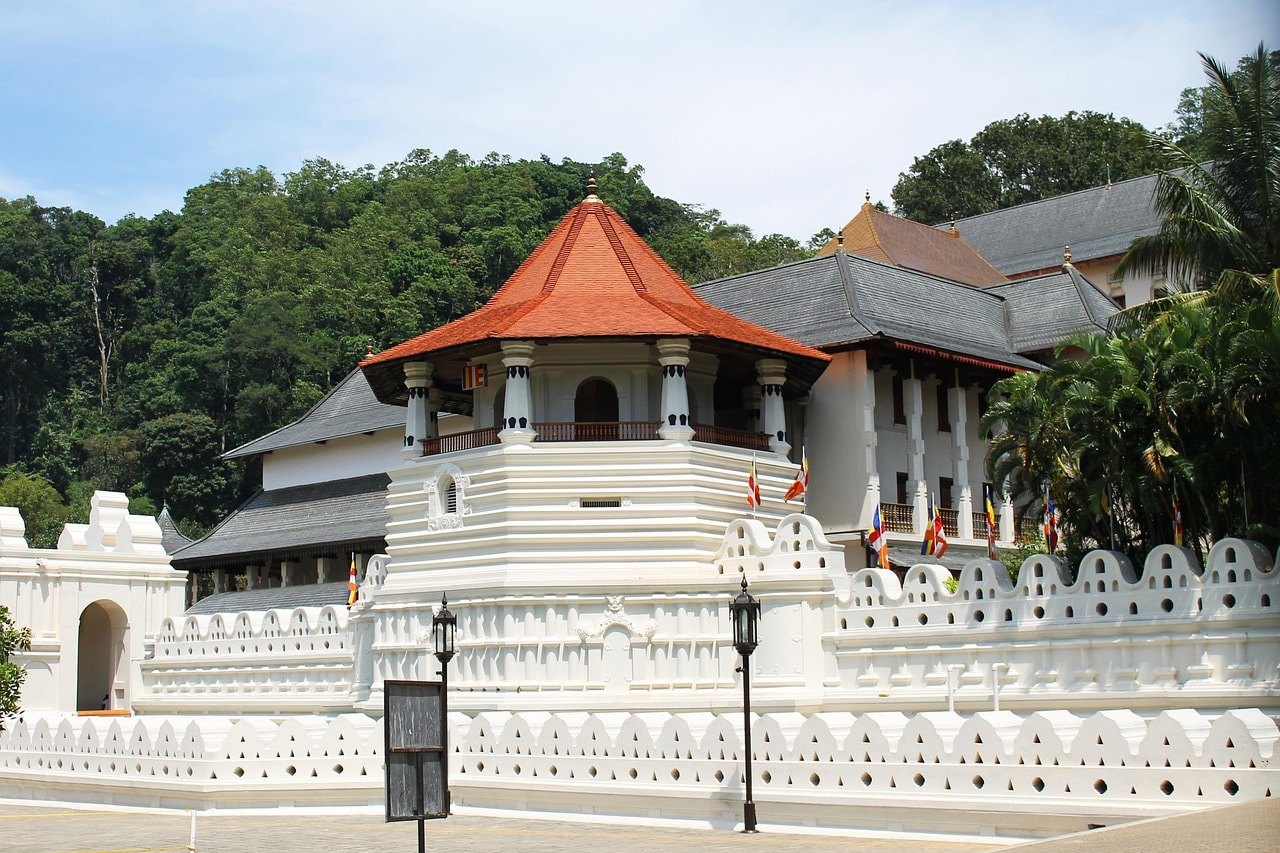
Visitors can witness daily rituals and appreciate the temple’s ornate architecture.
Take a leisurely walk around Kandy Lake, created by the last king of Kandy in 1807. The lake’s perimeter path offers excellent photography opportunities, especially during the golden hour when the temple and surrounding hills are reflected in the calm waters. Local fishermen often cast their lines from the lake’s edges, whilst water monitors and various bird species can be observed along the shores.
Visit the Kandy Cultural Centre for traditional dance performances that showcase the island’s rich cultural heritage. These performances feature drummers, dancers, and fire-walkers presenting stories from Buddhist and Hindu mythology. The elaborate costumes and athletic performances provide insight into traditions that have been passed down through generations.
Day 5: Kandy to Ella – The Famous Train Journey
Experience one of the world’s most scenic train rides from Kandy Railway Station to Ella. This journey through Sri Lanka’s hill country is often cited as one of the most beautiful train rides globally, and for good reason. The Ella train ride winds through emerald tea plantations, misty mountains, cascading waterfalls, and charming villages that seem untouched by time.
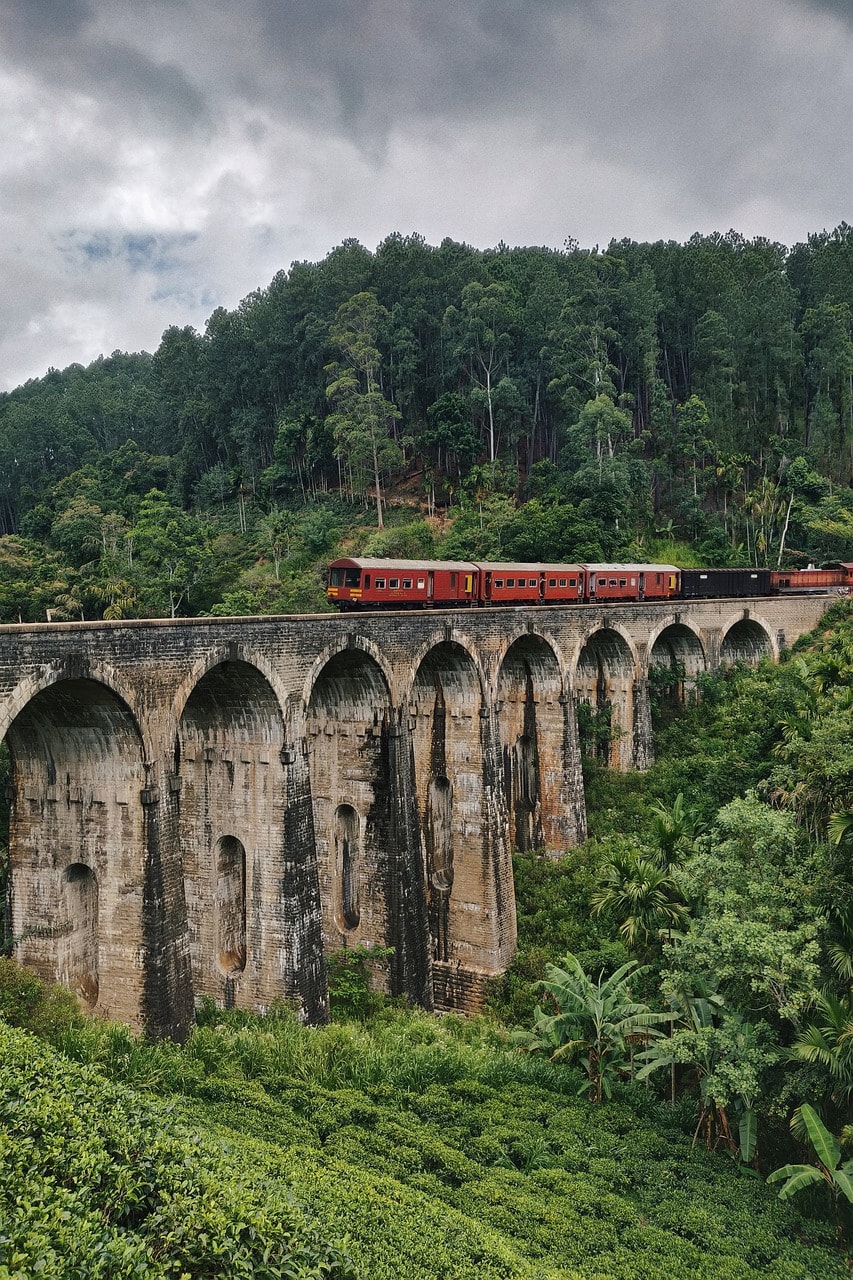
For the Kandy to Ella route, the right side of the train generally offers wider vistas.
Book your train ticket in advance, particularly for first-class or observation car seats that offer panoramic views through large windows. The journey takes approximately seven hours, but the spectacular scenery makes time pass quickly. The train departs Kandy in the morning, reaching the hill country’s most scenic sections during the best light of the day.
As the train climbs into the hills, the landscape transforms from tropical lowlands to cool, misty highlands. Tea plantations stretch as far as the eye can see, with workers visible among the bright green bushes harvesting the leaves that will become world-famous Ceylon tea. The train passes through numerous tunnels carved through the mountainsides, each emergence revealing new vistas.
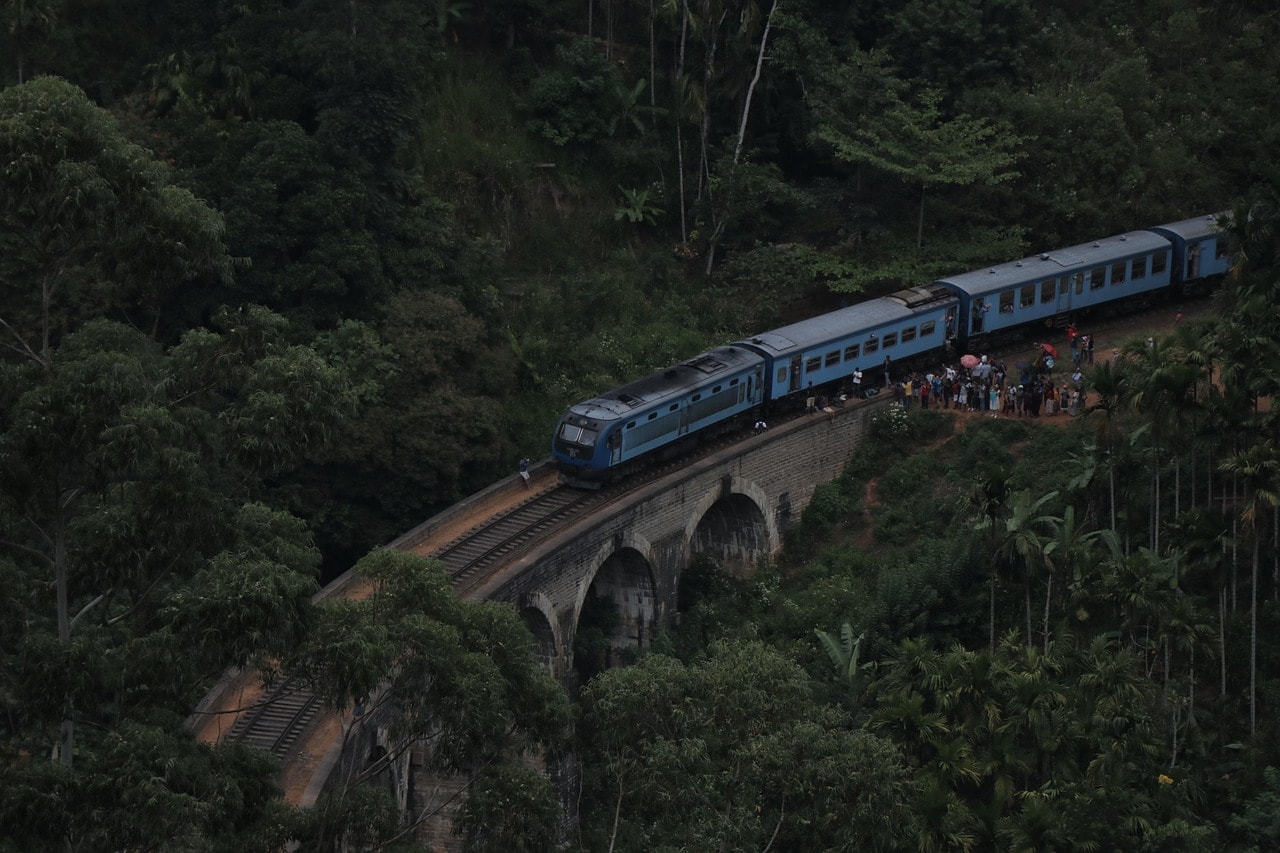
The dry season is generally considered the best time for this journey for clearer views.
Watch for the famous Nine Arch Bridge, one of the most photographed spots in Sri Lanka. This architectural marvel, built during the British colonial period, was constructed using only brick, rock, and cement—no steel was used in its construction. The bridge spans a deep valley surrounded by lush greenery, and the sight of a train crossing it has become iconic.
The train journey includes stops at several hill stations, each offering unique character and attractions. Nanu Oya serves as the station for Nuwara Eliya, often called “Little England” for its colonial architecture and cool climate. Haputale offers dramatic views across the southern plains, whilst Demodara features the famous loop where the train travels over itself.
Day 6-7: Ella – Hill Country Paradise
Ella epitomises the beauty of Sri Lanka’s hill country, surrounded by rolling tea plantations and dramatic mountain peaks. This small town has evolved from a quiet railway stop into a favourite destination among travellers seeking natural beauty, adventure, and a relaxed atmosphere.
The town’s main street bustles with cafes, guesthouses, and shops catering to international visitors, yet it maintains an authentic Sri Lankan character. Local families run many of the businesses, and the warm hospitality creates a welcoming atmosphere for travellers.
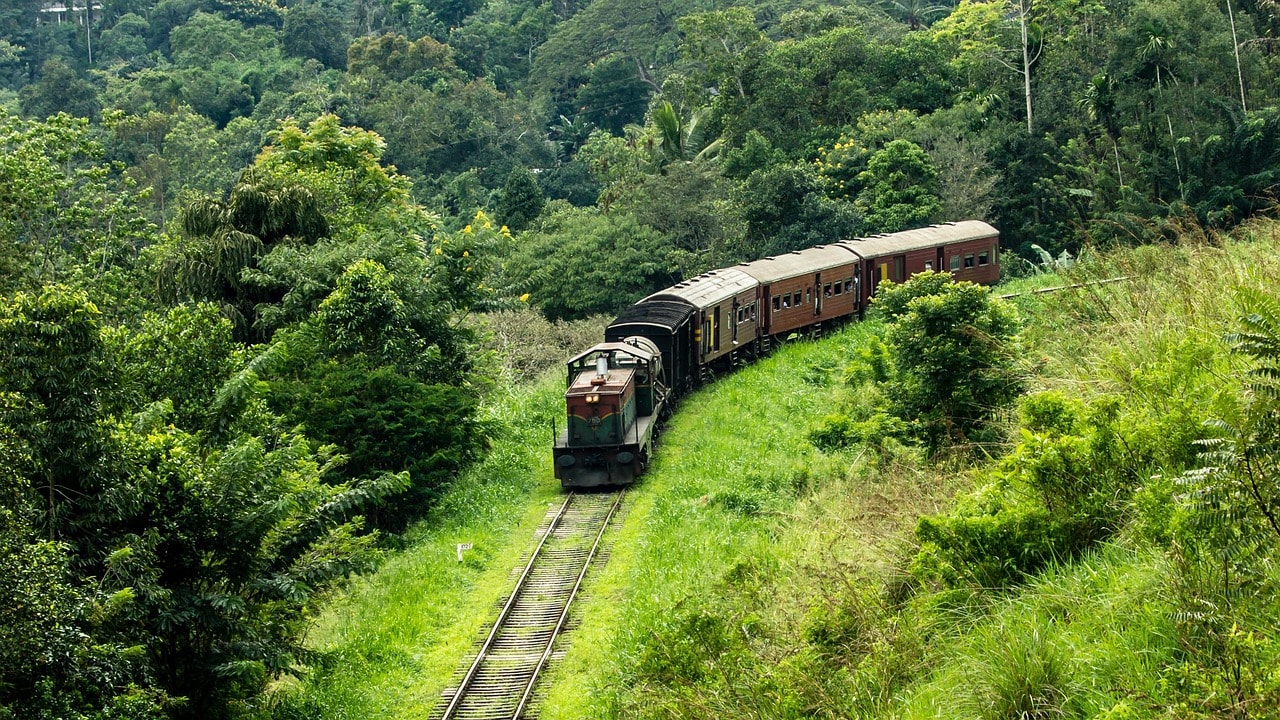
The views are particularly spectacular during sunrise and sunset.
Hike to Little Adam’s Peak for spectacular sunrise views over the surrounding valleys. The relatively easy trek takes about 45 minutes through tea plantations and forest paths. The summit provides 360-degree views of the hill country, with tea-covered hills rolling to the horizon in every direction. The best time for the hike is early morning, when the air is cool and the light is perfect for photography.
Visit a working tea plantation to learn about Ceylon tea production from leaf to cup. Many plantations offer private tours that explain the cultivation, harvesting, and processing methods that have made Sri Lankan tea famous worldwide. The tours typically include tastings of different tea varieties, from delicate white teas to robust black teas.
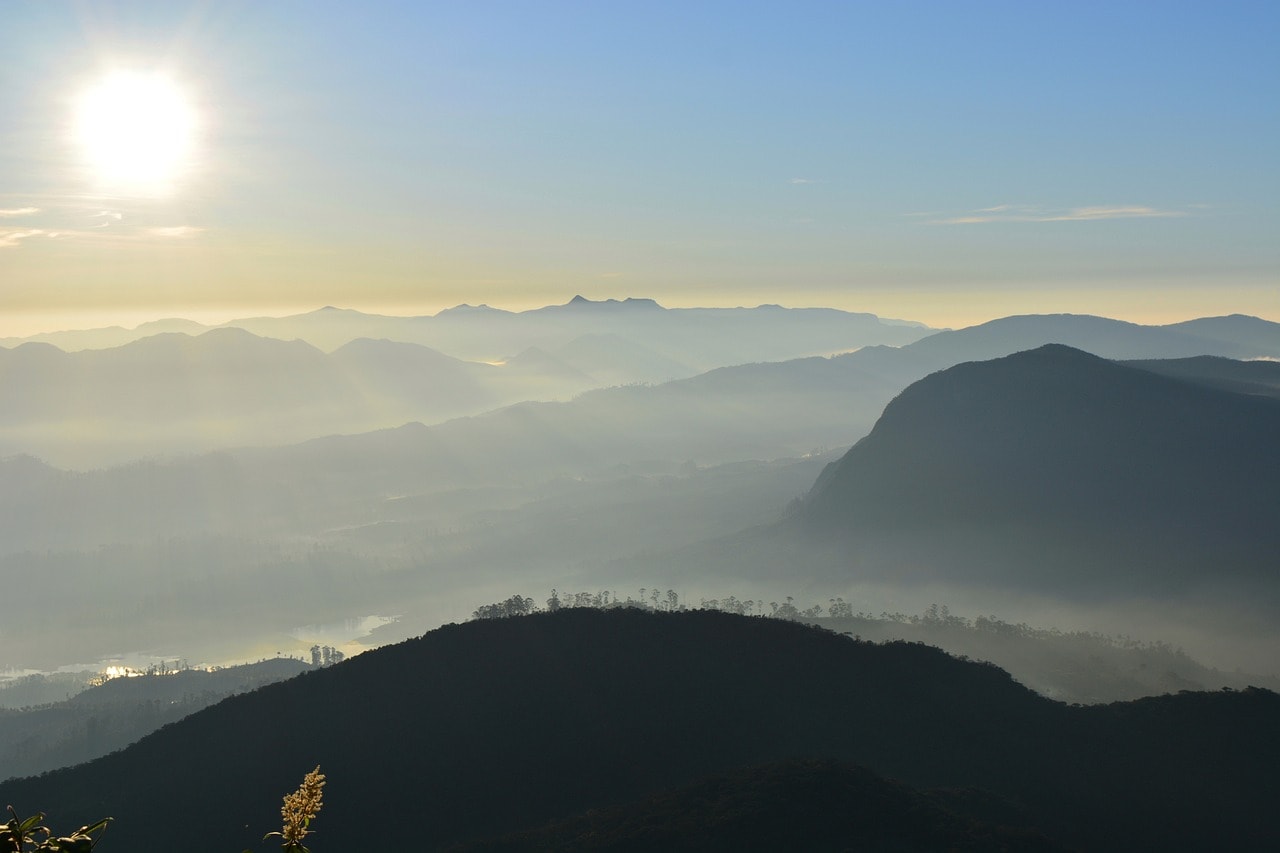
The hike to Little Adam’s Peak is considered relatively easy and suitable for all fitness levels.
The Lipton’s Seat viewpoint, named after the famous tea magnate Sir Thomas Lipton, offers panoramic views across the tea estates. The viewpoint is accessible by tuk-tuk or on foot, and the journey itself provides insights into rural life in the hill country. Local tea pickers often sell fresh tea leaves and homemade snacks along the route.
The famous Nine Arch Bridge, also known as the “Bridge in the Sky,” provides excellent photo opportunities and is easily accessible from Ella town. The bridge is particularly photogenic when trains pass through, usually in the morning and late afternoon. The surrounding forest includes several walking trails that offer different perspectives of the bridge and valley.
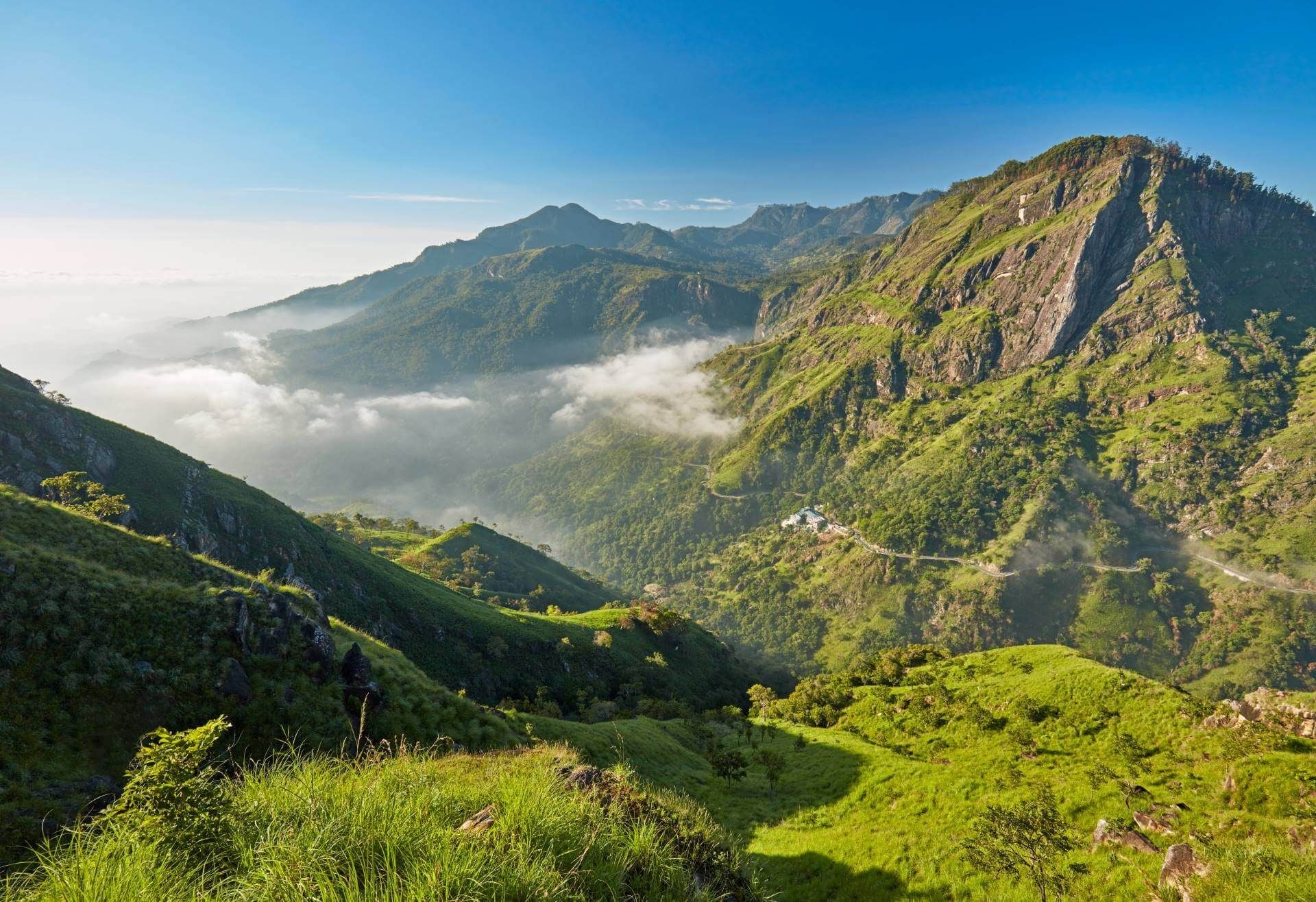
This is a popular and more challenging hike that offers superb views of Ella Gap from its summit.
Explore the Ella Gap, a dramatic opening in the mountains that provides views all the way to the south coast on clear days. The gap creates a natural wind tunnel, and the constant breeze makes it a popular spot for relaxation and photography. Local guides offer walks through the surrounding forest, pointing out endemic plants and bird species.
Week 2: Wildlife and Ancient Wonders
Day 8-9: Yala National Park Day – Wildlife Safari Adventure
Journey to Yala National Park, Sri Lanka’s most famous wildlife reserve and home to one of the world’s highest leopard densities. The park covers 979 square kilometres and encompasses diverse ecosystems including forests, grasslands, lagoons, and coastal areas along the Indian Ocean.
Yala’s unique position combines inland wilderness with coastal beauty, creating habitats for an incredible variety of wildlife. The park is divided into five blocks, with Block 1 being the most visited and offering the best facilities for wildlife viewing.
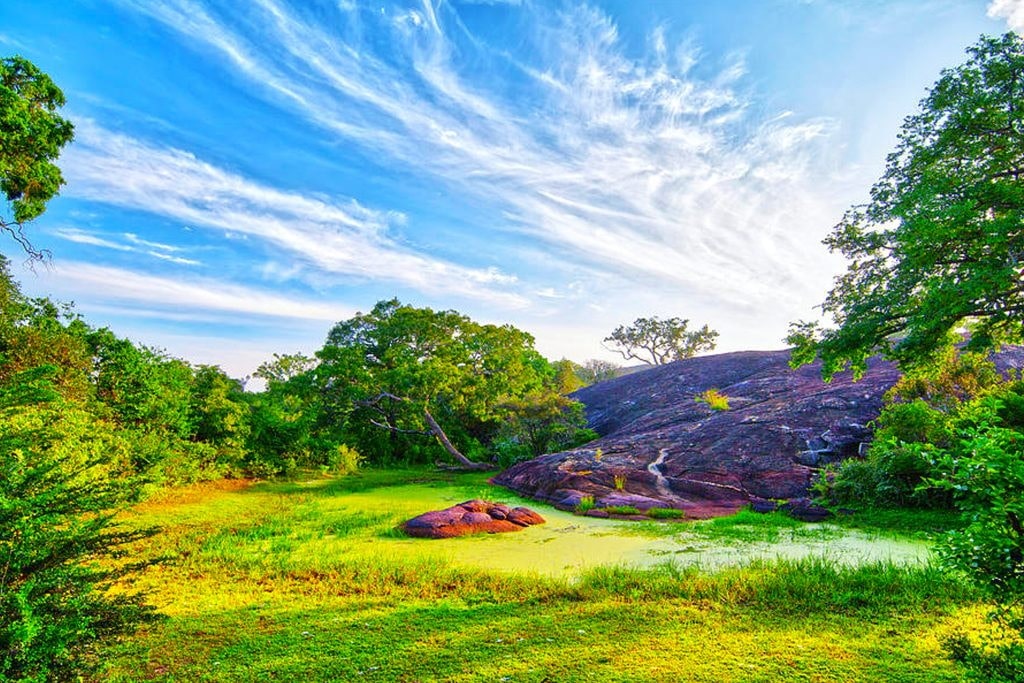
Yala is a hotspot for birdwatching, home to hundreds of bird species, including many migratory birds.
Join early morning game drives for the best wildlife viewing opportunities. The golden hours just after sunrise provide excellent lighting for photography and are when many animals are most active. Leopards, the park’s most famous residents, are often spotted lounging in trees or prowling along rocky outcrops. The park’s leopard population is estimated at around 30-40 individuals, making it one of the best places in the world to observe these magnificent cats.
Besides leopards, Yala is home to large herds of elephants, often seen near water sources during the dry season. The park’s elephant population includes families with baby elephants, providing heartwarming viewing opportunities. Water buffalo, spotted deer, wild boar, and several species of monkeys are commonly observed during game drives.
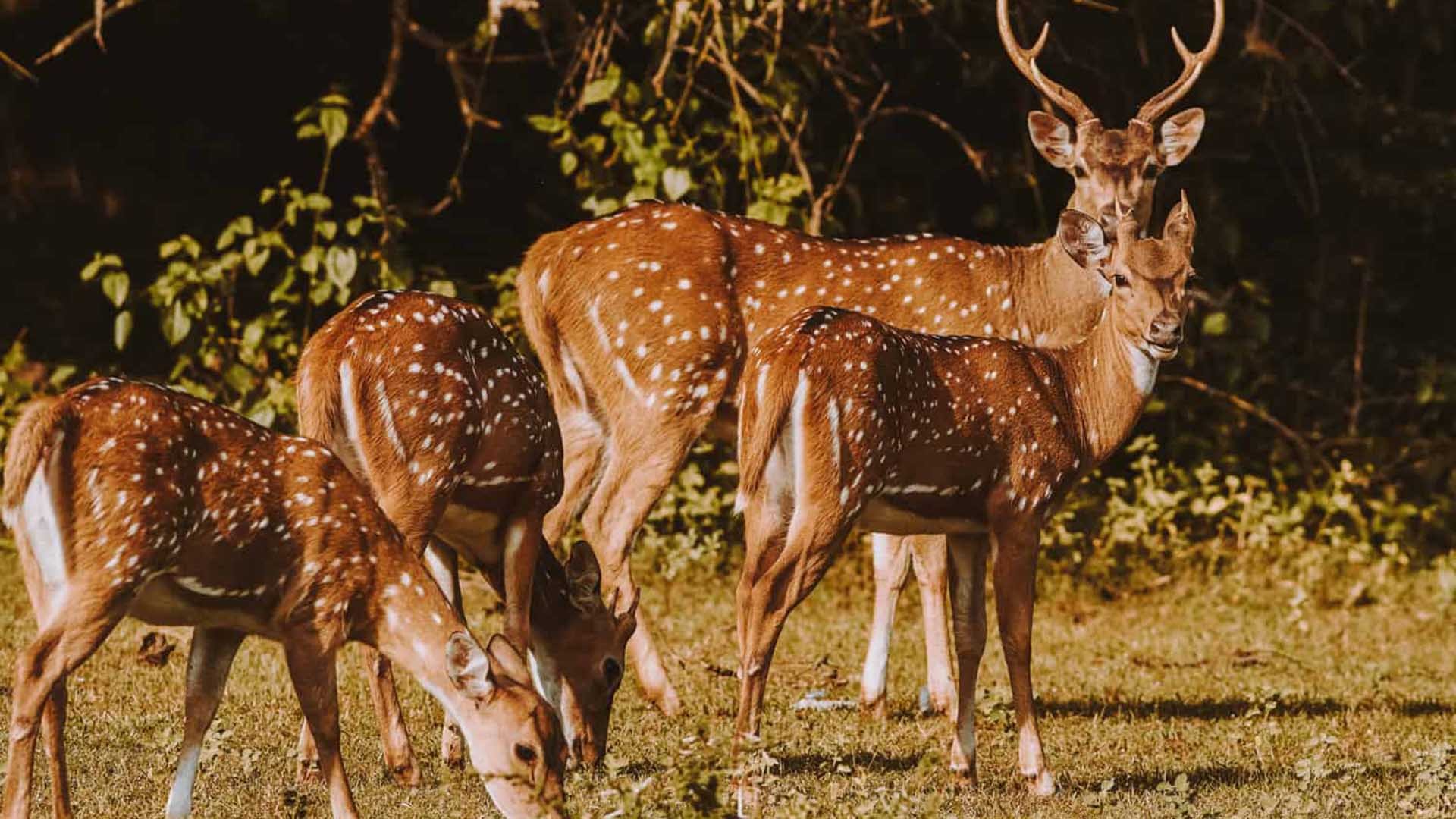
A newly developed reservoir, excellent for photography, where many wild animals gather for water.
The park’s birdlife is equally impressive, with over 200 species recorded. Peacocks strut through the forest clearings, whilst various species of eagles, hawks, and owls patrol the skies. The coastal areas attract numerous water birds, including painted storks, spoonbills, and various species of herons and egrets.
Late afternoon game drives offer different wildlife viewing opportunities as animals prepare for evening activities. The changing light creates dramatic photography conditions, with golden hour illuminating the landscape and wildlife. Many animals, including leopards, become more active as temperatures cool.

Herds of Asian elephants can be seen grazing, bathing in waterholes, or even crossing the park’s roads.
The park’s coastal location means some areas feature beautiful beaches where you can observe wildlife against the backdrop of the Indian Ocean. Patanangala Beach within the park offers a unique combination of wildlife viewing and seaside scenery. Elephants sometimes venture onto the beach, creating incredible photo opportunities.
Consider staying at one of the eco-lodges near the park entrance for an immersive wildlife experience. Many lodges offer guided nature walks around their properties, bird watching excursions, and talks about conservation efforts. The lodges often feature traditional architecture and serve authentic Sri Lankan cuisine.
Day 10: Udawalawe National Park – Elephant Sanctuary
Travel to Udawalawe National Park, renowned for its large elephant population and excellent wildlife viewing opportunities. The park covers 30,821 hectares and was created in 1972 following the construction of the Udawalawe Reservoir. The park’s open grasslands and large water body create perfect conditions for elephant observation.
The elephant safari here offers almost guaranteed sightings, with herds frequently gathering around the Udawalawe Reservoir during the dry season. The park’s elephant population numbers around 400-500 individuals, making it one of the best places in Asia to observe these magnificent creatures in their natural habitat.
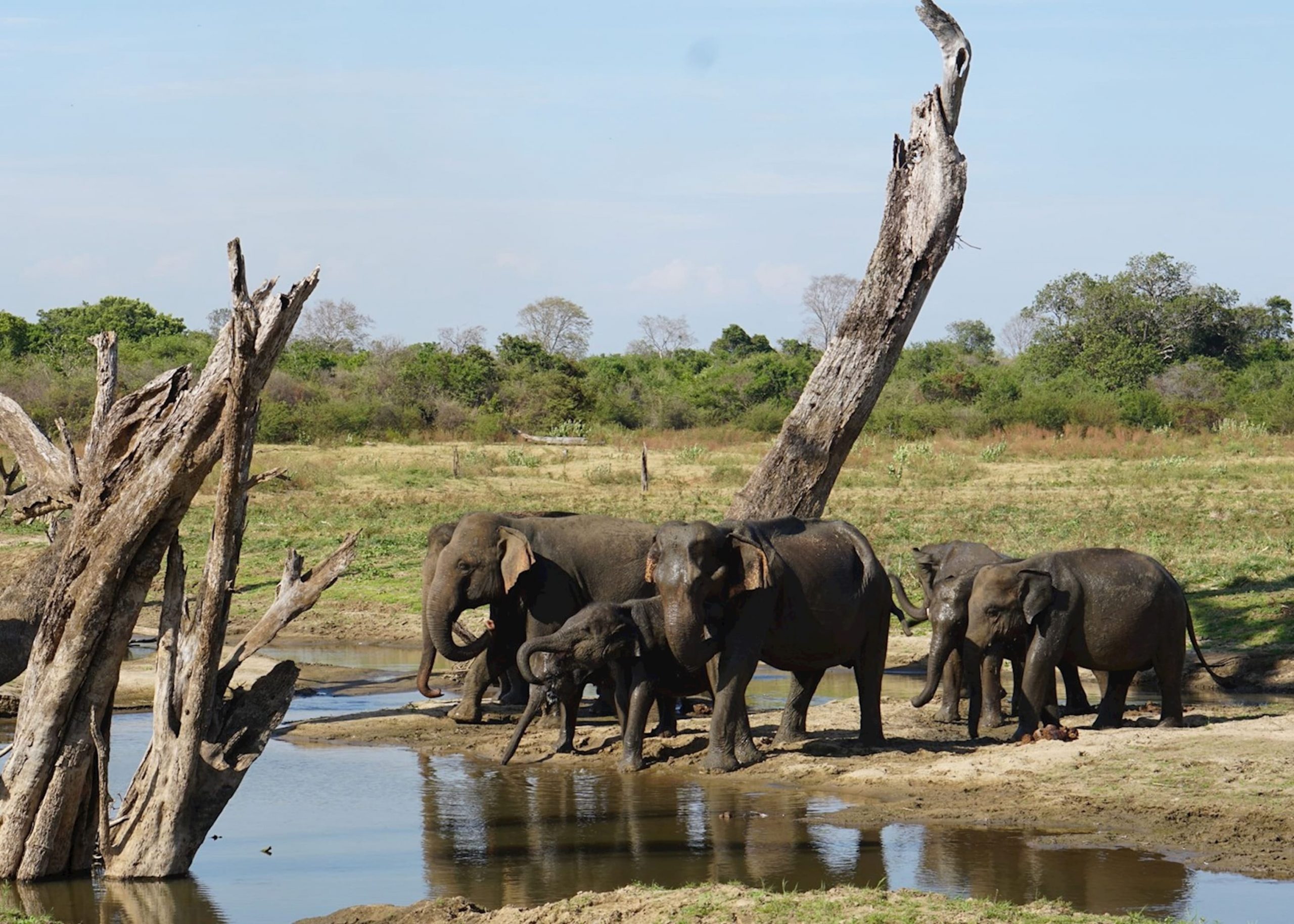
Udawalawe is considered one of the best locations in Sri Lanka for sightings of wild elephants throughout the year.
The park’s relatively open terrain makes wildlife spotting easier compared to denser forest reserves. Large herds of elephants, often including several generations of family groups, gather at water sources throughout the day. The sight of baby elephants playing whilst their mothers feed nearby provides some of the most heartwarming wildlife viewing experiences in Sri Lanka.
Besides elephants, the park is home to water buffalo, spotted deer, wild boar, and several species of monkeys. The reservoir attracts numerous water birds, including painted storks, pelicans, and various species of ducks and geese. Crocodiles can often be spotted sunning themselves along the reservoir’s edges.
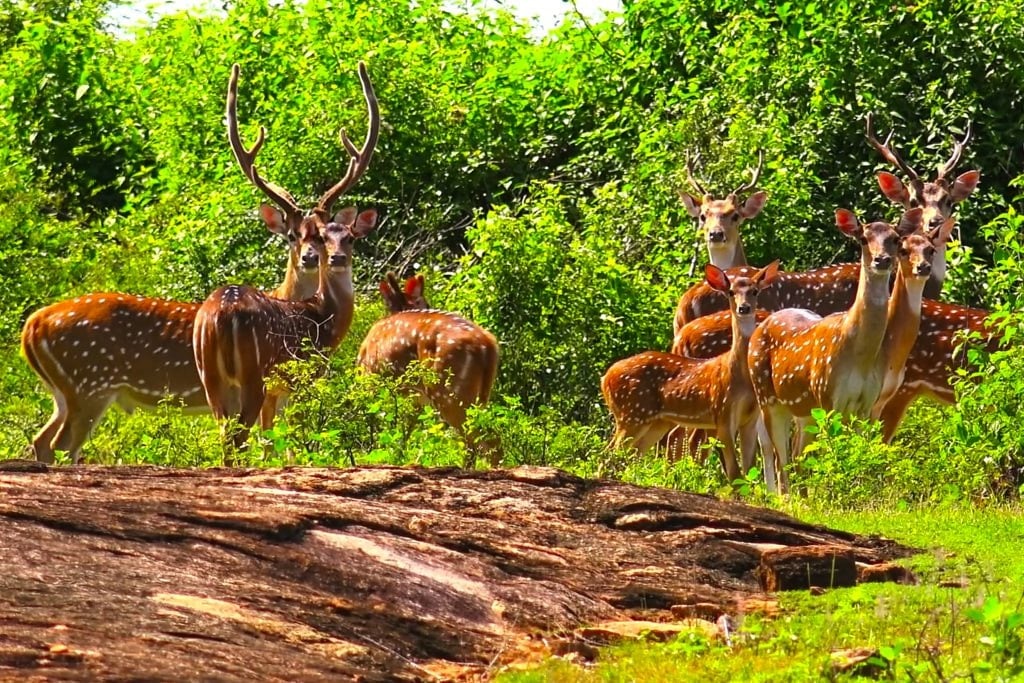
Beyond elephants, the park is home to a rich variety of other animals.
Visit the Elephant Transit Home, a rehabilitation centre for orphaned elephant calves located near the park. The centre was established in 1995 and has successfully rehabilitated over 200 elephants. The feeding times, which occur at 9:00 AM, 12:00 PM, 3:00 PM, and 6:00 PM, provide opportunities to observe baby elephants up close whilst supporting important conservation efforts.
The transit home’s mission is to provide care for orphaned elephants until they can be released back into the wild. Visitors can observe the elephants from a safe distance and learn about the rehabilitation process. The centre also conducts research on elephant behaviour and conservation, contributing to broader efforts to protect Sri Lanka’s elephant population.
Design your perfect Sri Lanka trip today!
Work with your expert local travel designer to customise your itinerary so it is exactly what you want from a Sri Lanka trip. Get exclusive experiences, top-rated restaurants, and hotels that fit your interests.
Day 11-12: Sigiriya – The Lion Rock
Explore one of Sri Lanka’s most iconic UNESCO World Heritage Sites and one of the most spectacular archaeological sites in the world. Sigiriya, known as Lion Rock, rises dramatically 200 metres above the surrounding plains and houses the ruins of an ancient royal palace complex built in the 5th century CE.
The site’s history is as dramatic as its appearance. King Kasyapa chose this location for his capital after seizing power from his father and fearing retribution from his brother. The king transformed the rocky outcrop into a magnificent palace complex, complete with gardens, pools, and elaborate frescoes.
The climb to the summit takes about two hours and includes several stops to admire the engineering marvels created 1,500 years ago. The journey begins through the water gardens, which demonstrate sophisticated hydraulic engineering that still functions today. The gardens feature pools, fountains, and channels that create a cooling effect in the tropical heat.

Beyond elephants, the park is home to a rich variety of other animals.
The boulder gardens contain massive rocks that were incorporated into the palace design, with some featuring carved steps and doorways. The terraced gardens climb the lower slopes of the rock, featuring pathways, staircases, and residential areas for the royal court.
Midway up the rock, visitors encounter the famous frescoes of the “Heavenly Maidens” or “Cloud Damsels.” These paintings, created using natural pigments, depict beautiful women in various poses and are considered masterpieces of ancient Sri Lankan art. Originally, there were about 500 frescoes, but only 22 survive today.
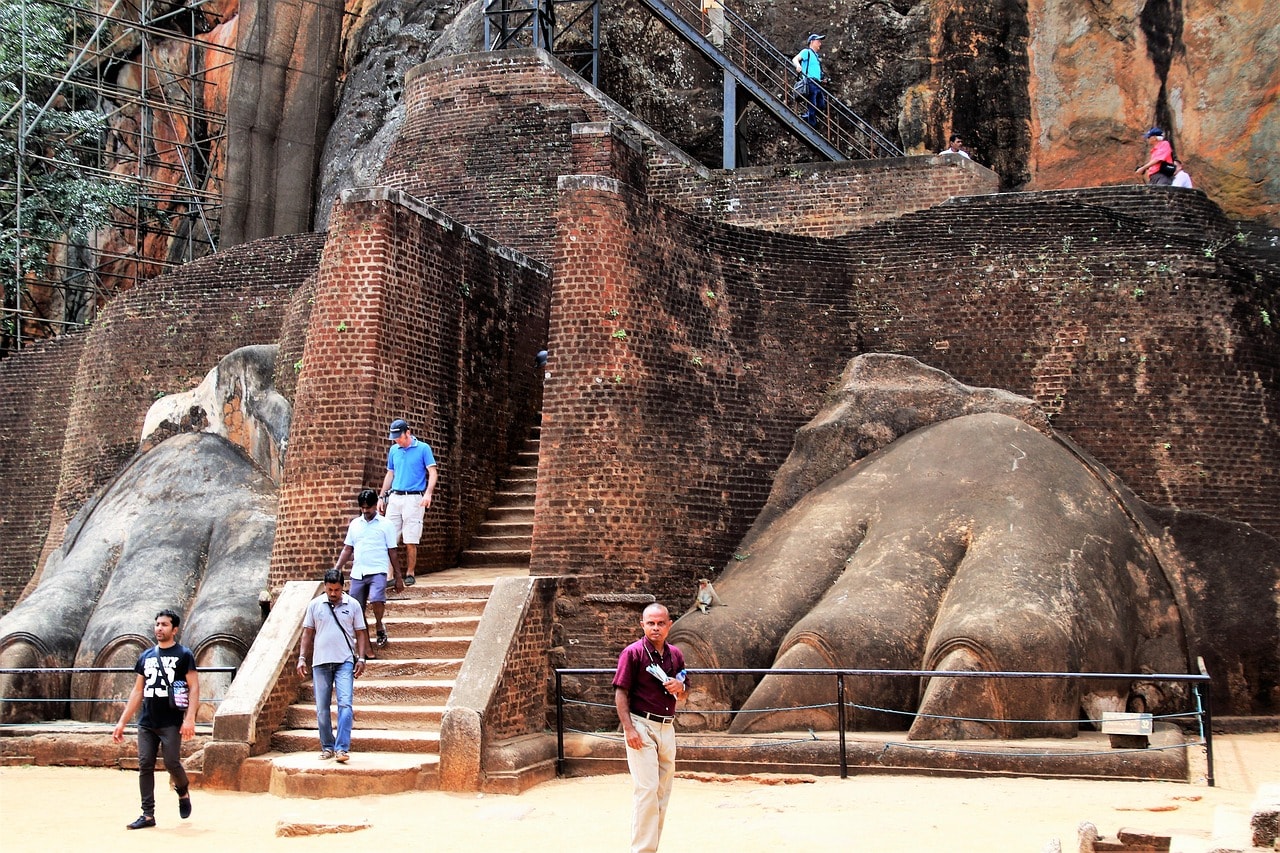
The ascent to the summit involves approximately 1,200 steps.
The Mirror Wall, a highly polished surface that once reflected the king’s image, contains ancient graffiti dating back over 1,000 years. These inscriptions, written in ancient Sinhala, provide insights into the thoughts and feelings of ancient visitors to the site.
The final ascent involves climbing through the Lion’s Paws, two enormous stone paws that are all that remain of a massive lion sculpture that once guarded the entrance to the palace. The original lion’s head and body have long since crumbled, but the paws give visitors an idea of the sculpture’s former grandeur.
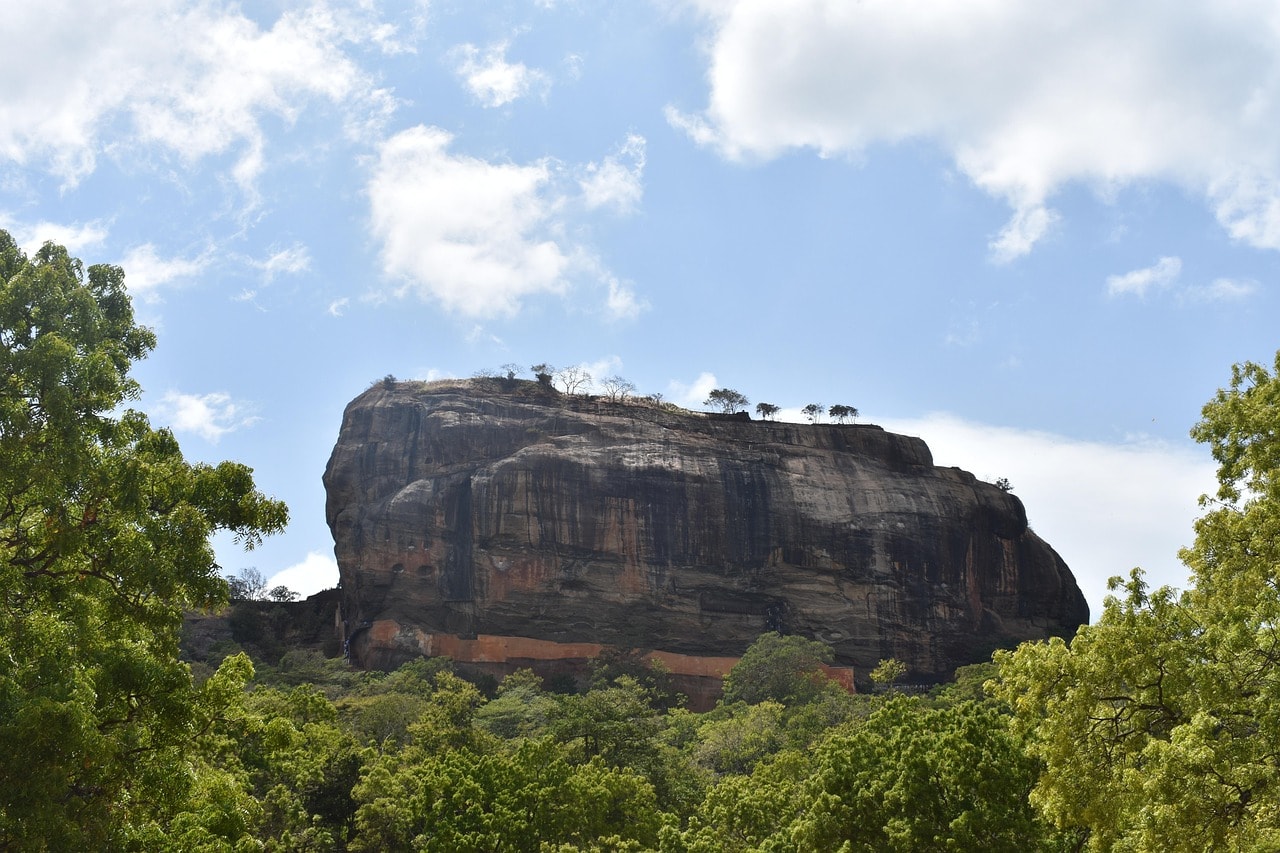
Sigiriya is a central point within Sri Lanka’s “Cultural Triangle”.
The summit offers breathtaking views across the central Sri Lankan landscape, making the challenging climb worthwhile. The palace ruins include the foundations of the royal chambers, audience halls, and a sophisticated water management system. The king’s throne area is carved directly into the rock, and the views from this vantage point explain why this location was chosen for the royal residence.
Early morning visits help avoid crowds and the intense heat of midday. The site opens at 7:00 AM, and arriving early provides the best conditions for photography and peaceful exploration. The changing light throughout the day creates different moods and photographic opportunities.
Day 13: Polonnaruwa – Ancient Capital
Visit Polonnaruwa, another UNESCO World Heritage Site and the second capital of ancient Sri Lanka. The well-preserved ruins offer insights into medieval Sinhalese civilisation and represent one of the best-preserved ancient cities in South Asia.
Polonnaruwa served as the capital from the 11th to 13th centuries, during which time it was one of the most important cities in Asia. The ruins spread across a large area and include palaces, temples, stupas, and other religious and secular buildings that showcase the architectural achievements of ancient Sri Lanka.
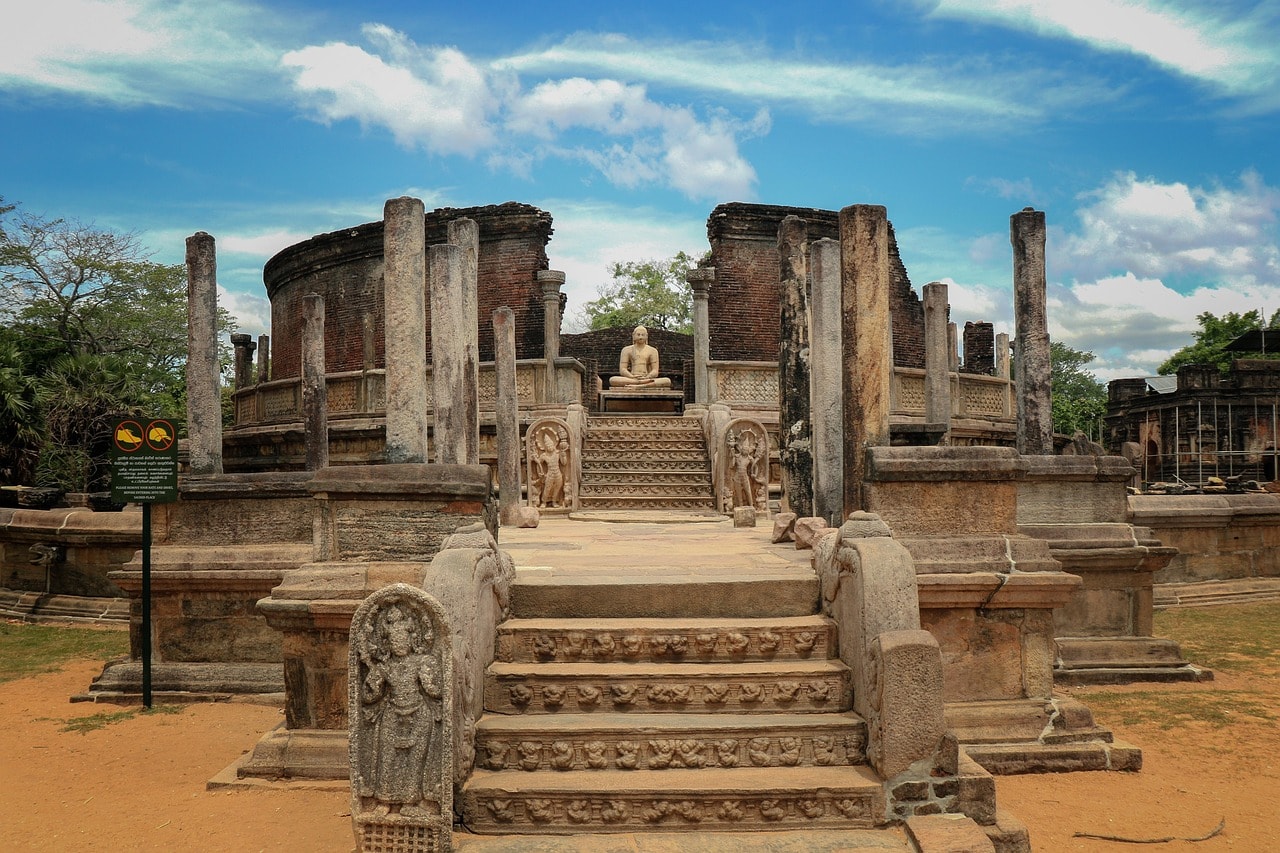
The smallest gedige (hollow Buddhist temple with thick walls) in Polonnaruwa.
The Quadrangle (Dalada Maluva) houses the most significant religious structures in a compact area. The Vatadage, a circular building with carved stone pillars, is considered one of the finest examples of ancient Sinhalese architecture. The structure was built to house the sacred tooth relic and features intricate stone carvings depicting Buddhist themes.
The Thuparama Gedige, the best-preserved building in Polonnaruwa, demonstrates the influence of South Indian architecture on Sri Lankan building styles. The structure’s thick walls and distinctive shape make it unique among Sri Lankan religious buildings.
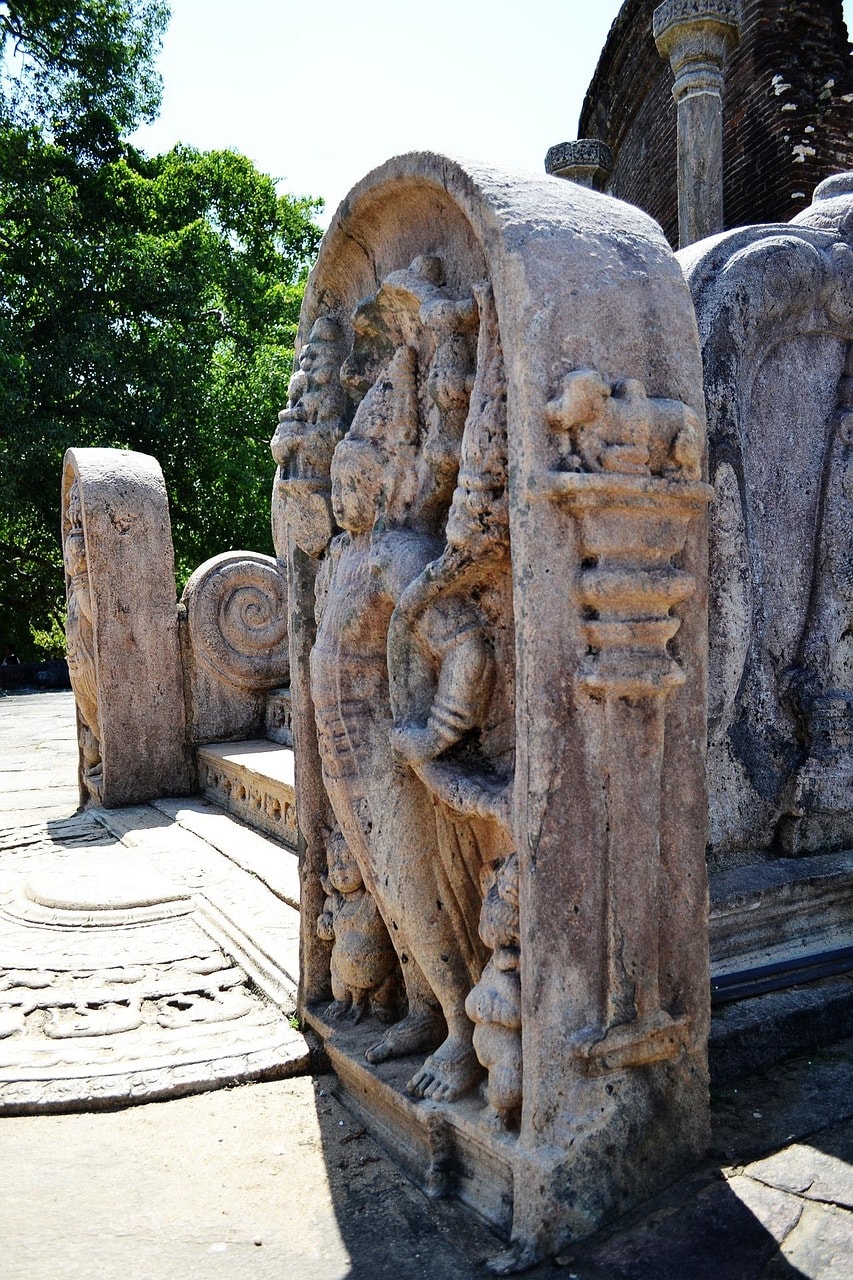
Structures believed to have housed the Sacred Tooth Relic of Buddha.
The Gal Vihara features four magnificent Buddha statues carved from a single granite wall. The statues, created in the 12th century, represent different aspects of Buddha’s teachings and are considered among the finest examples of ancient Sinhalese sculpture. The standing Buddha statue is 23 feet tall, whilst the reclining Buddha measures 46 feet in length.
The Royal Palace complex includes the remains of King Parakramabahu’s palace, which originally stood seven stories high. The thick walls and impressive foundations give visitors an idea of the building’s former grandeur. The Audience Hall features stone pillars and platforms where the king held court.
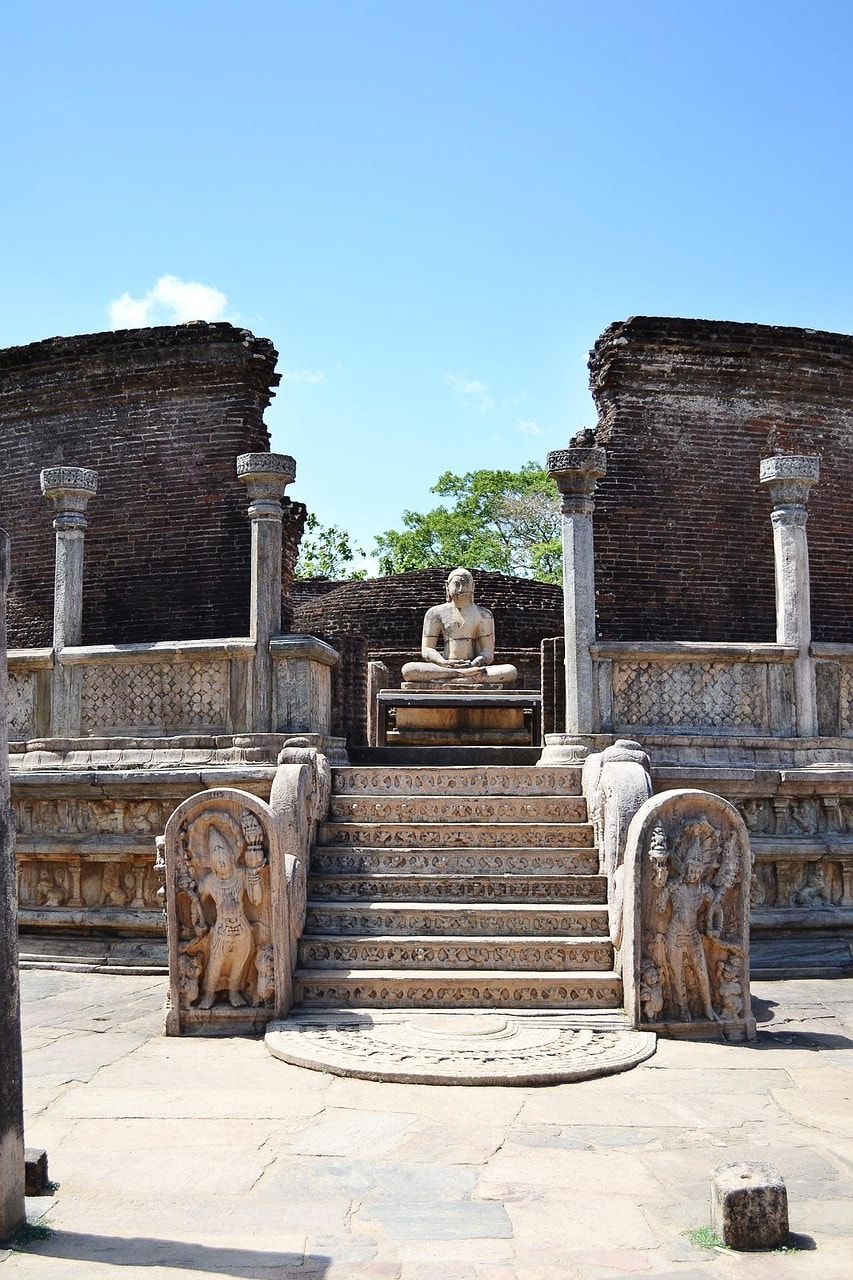
The oldest building in Polonnaruwa, dating back to the Chola dynasty.
The Parakrama Samudra, a massive reservoir built by King Parakramabahu, demonstrates ancient Sri Lankan hydraulic engineering skills. The reservoir, which covers over 5,000 acres, continues to provide water for irrigation and is home to numerous bird species.
Rent bicycles to explore the extensive archaeological site comfortably. The flat terrain and well-maintained paths make cycling an ideal way to cover the large area whilst enjoying the peaceful atmosphere. Many of the ruins are connected by ancient roads that are still used today.
Week 3: Beaches and Coastal Adventures
Day 14-15: Galle – Colonial Charm and Coastal Beauty
Travel to the southern coast to explore Galle, a UNESCO World Heritage Site famous for its remarkably preserved Dutch colonial architecture and strategic coastal location. The city represents one of the finest examples of a European-fortified city in South Asia and showcases the blend of European and Asian architectural styles.
Galle Fort, built by the Portuguese in 1588 and later extensively fortified by the Dutch, remains one of Asia’s finest examples of a fortified city. The fort’s massive walls, bastions, and ramparts have withstood centuries of monsoons and remain largely intact. The fort area, covering about 90 acres, contains narrow streets lined with colonial buildings, many of which have been converted into boutique hotels, galleries, and restaurants.
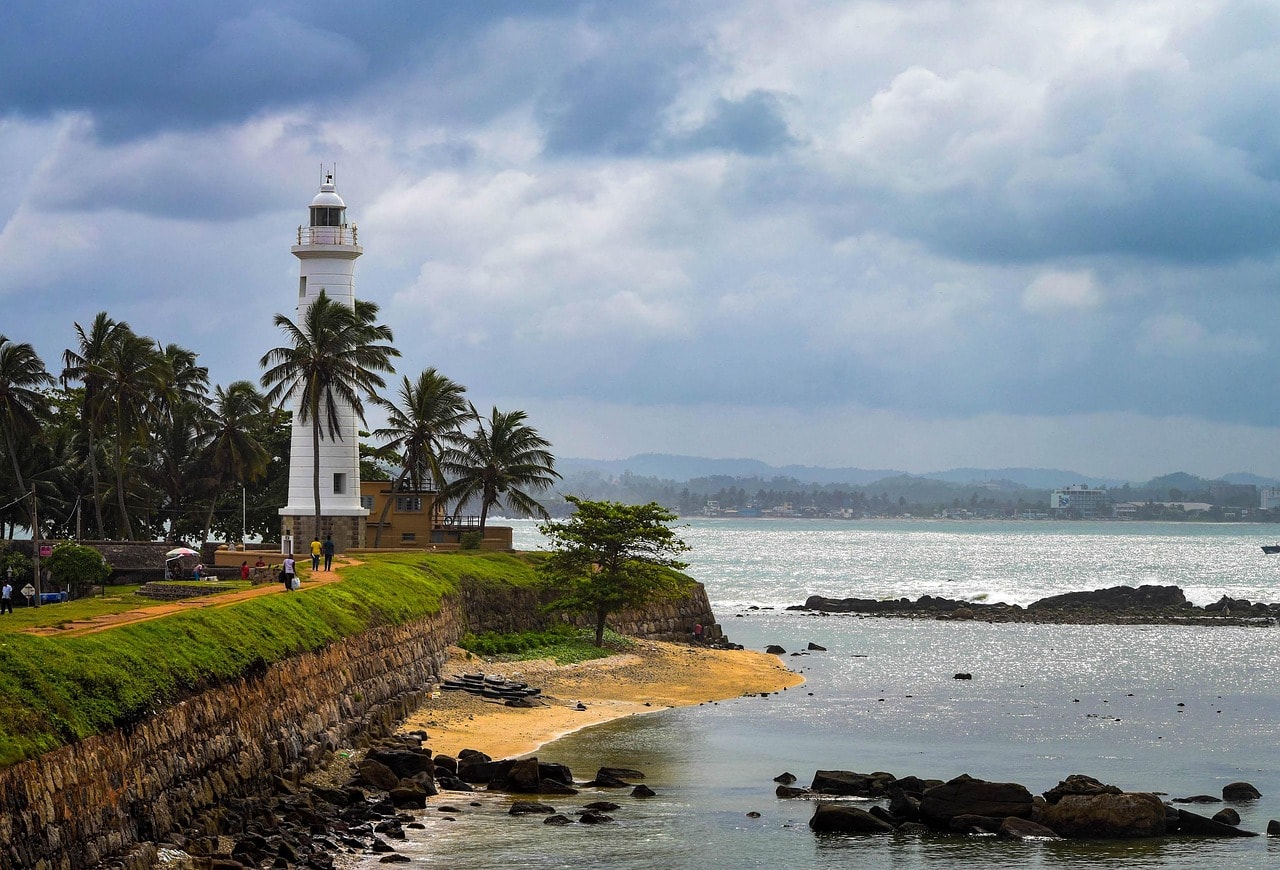
Strolling along the ancient ramparts offers panoramic views of the Indian Ocean and the city.
Walk along the fort’s ramparts for stunning views of the Indian Ocean and the city below. The ramparts provide excellent vantage points for photography, especially during the golden hours of sunrise hike and sunset. The Flag Rock area is particularly popular for sunset viewing, with couples and families gathering to watch the sun disappear into the ocean.
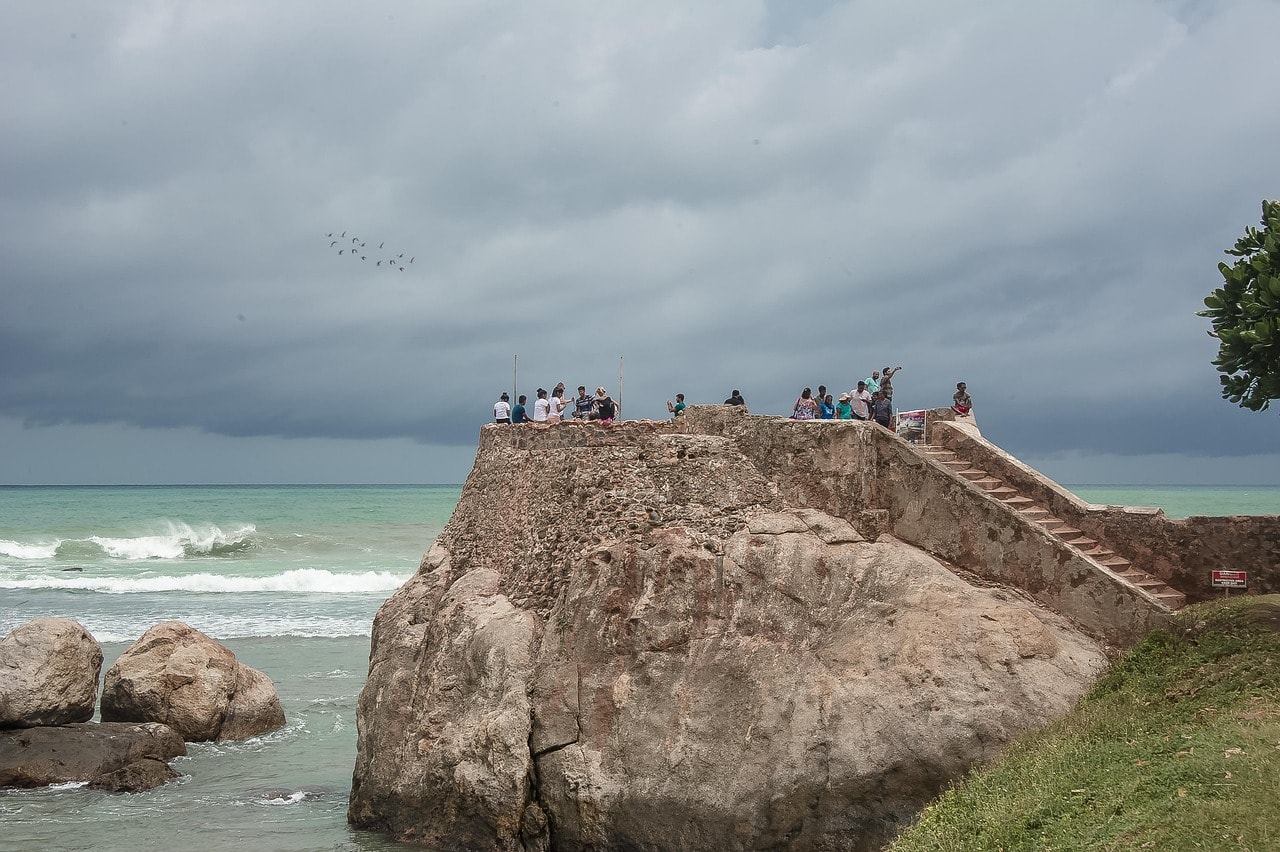
A beautiful mosque with Italian flooring, chandeliers, and artistic glass.
The fort’s lighthouse, built in 1938, stands at the southeastern tip of the fort and has become an iconic symbol of Galle. The lighthouse is still operational and provides navigation assistance to ships passing along the coast. The nearby clock tower, built in 1883, commemorates the Golden Jubilee of Queen Victoria’s reign.
Explore the narrow streets within the fort, where colonial buildings house an eclectic mix of shops, cafes, and galleries. The Dutch Reformed Church, built in 1752, features beautiful stained glass windows and a historic pipe organ. The church’s interior contains Dutch colonial tombstones and memorials that tell the story of Galle’s colonial past.
An iconic and picturesque landmark at the edge of the fort walls.
Visit the National Maritime Museum, housed in a Dutch colonial building, to learn about Sri Lanka’s maritime heritage and the fort’s strategic importance in the spice trade. The museum’s collection includes ancient maps, navigation instruments, and artifacts recovered from shipwrecks along the coast.
The Galle International Cricket Stadium, located within the fort walls, is one of the most scenic cricket grounds in the world. The stadium hosts international matches and provides a unique sporting experience with views of the fort walls and ocean beyond.
Day 16-17: Mirissa – Whale Watching and Beach Relaxation
Experience some of Sri Lanka’s most beautiful beaches in Mirissa, known for its stunning sunsets, excellent whale watching opportunities, and relaxed atmosphere. This small fishing village has developed into one of the island’s premier beach destinations whilst maintaining its authentic character.
Mirissa Beach features a perfect crescent of golden sand backed by palm trees and small guesthouses. The beach’s protected bay creates calm swimming conditions, whilst the nearby coral reefs offer excellent snorkelling opportunities. The beach’s western orientation provides spectacular sunset views that have made it famous among photographers and romantic travellers.
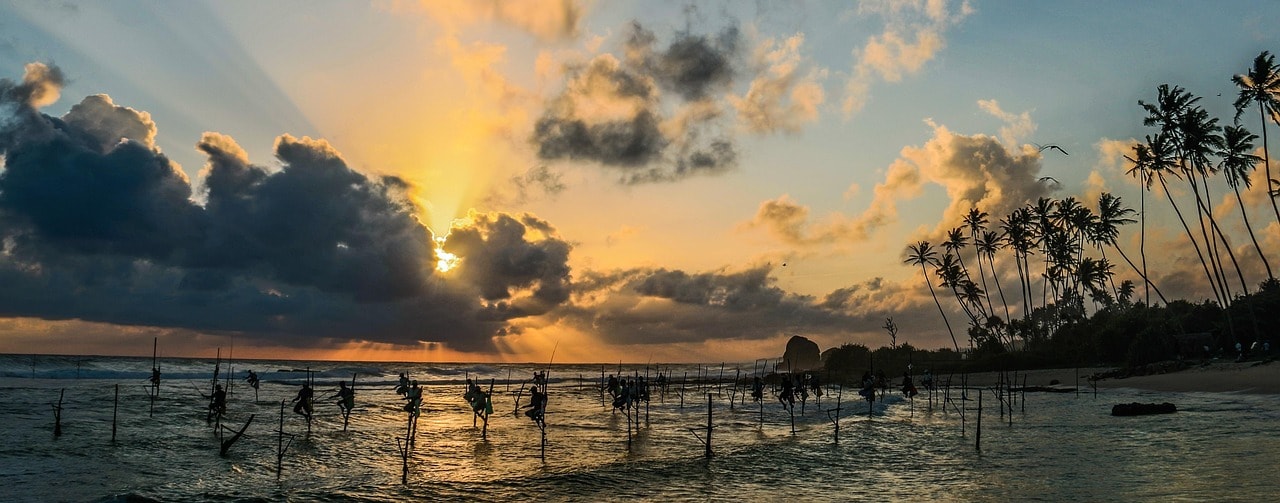
It’s ideal for swimming, sunbathing, and enjoying the relaxed, bohemian vibe.
Join a whale watching excursion to spot blue whales, the largest animals on Earth, along with sperm whales, pilot whales, and various dolphin species. The waters off Mirissa provide some of the best whale watching in the world, particularly from December to April when blue whales migrate through the area.
The whale watching boats typically depart early in the morning and spend 3-4 hours at sea. The excursions are conducted by local operators who understand whale behaviour and migration patterns. Besides whales, the half-day trips often provide opportunities to see dolphins, sea turtles, and various seabirds.
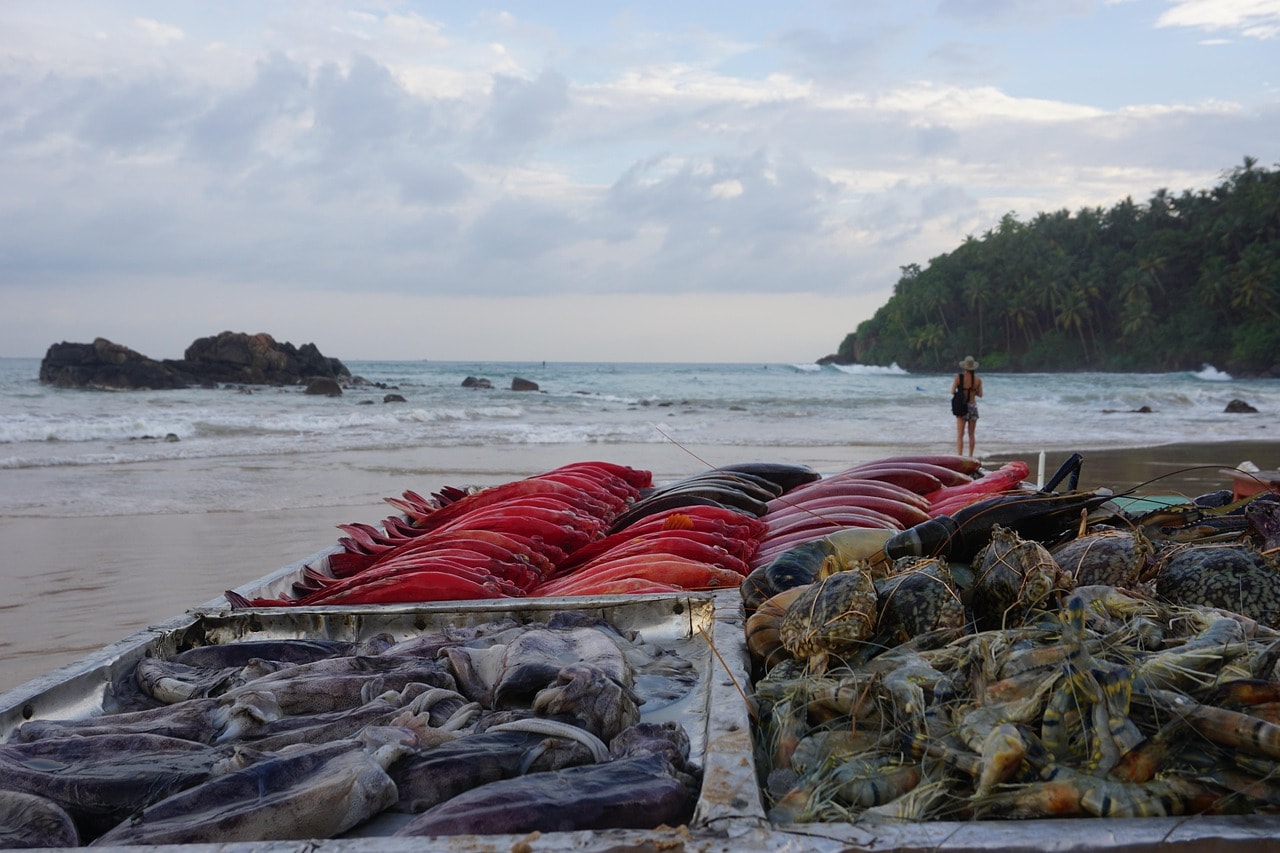
A smaller, more secluded cove located west of Mirissa Beach, offering a quieter escape.
Blue whales, which can reach lengths of up to 30 metres, are the main attraction. These magnificent creatures surface to breathe, sometimes providing spectacular displays as they breach or show their massive flukes. Sperm whales, though smaller, are equally impressive and can often be observed in family groups.
Coconut Tree Hill, situated on a small promontory near Mirissa, boasts panoramic views of the coastline and has become one of Sri Lanka’s most photographed spots on Instagram. The cluster of coconut palms creates a picture-perfect tropical scene, especially during the golden hours of sunrise and sunset.
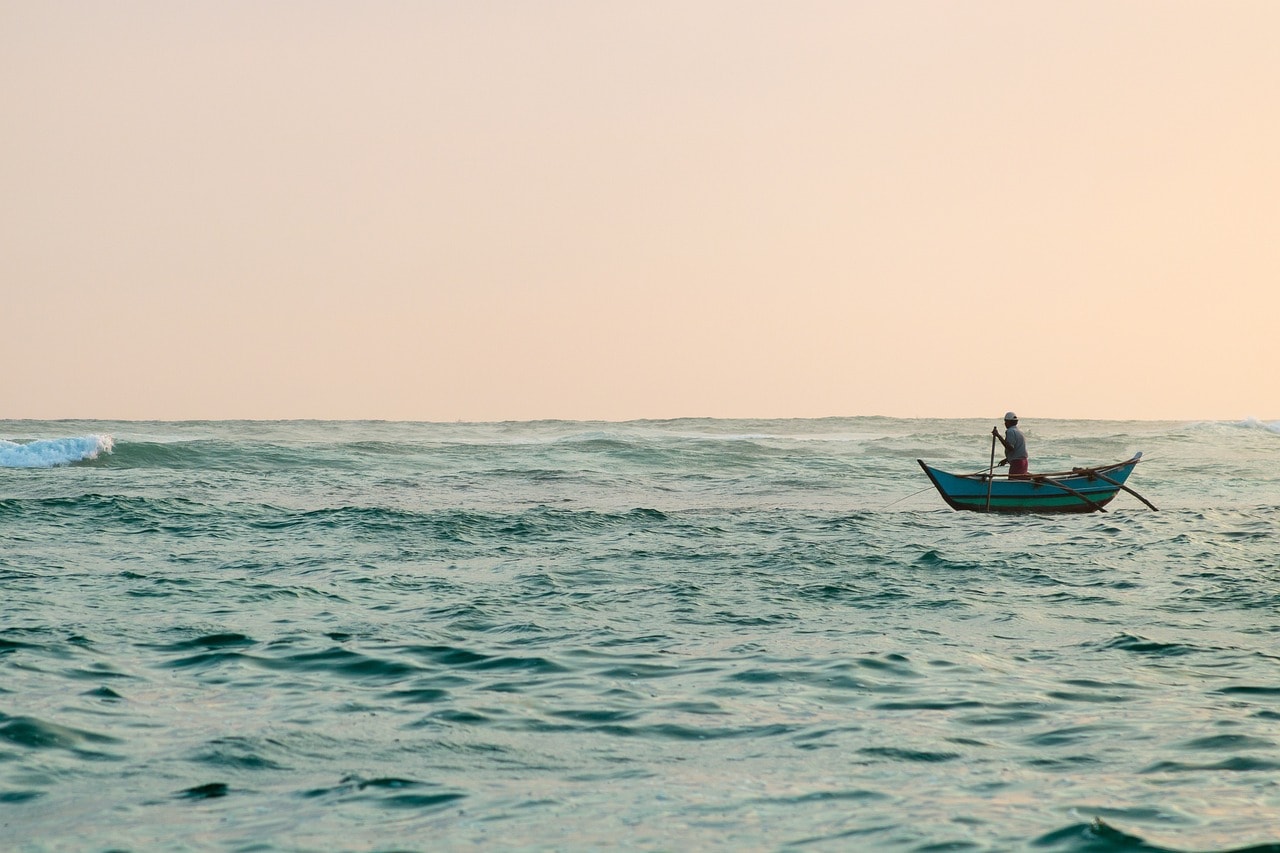
A small rocky island accessible by wading through shallow water from Mirissa Beach at low tide.
The hill is easily accessible by foot or tuk-tuk and provides excellent photography opportunities. The views encompass the entire Mirissa bay, neighbouring beaches, and the endless expanse of the Indian Ocean. Local vendors often sell fresh coconut water and tropical fruits at the site.
Enjoy fresh seafood at beachside restaurants whilst watching spectacular sunsets. Mirissa’s restaurants serve everything from grilled fish and prawns to traditional Sri Lankan curries, often accompanied by rice and fresh vegetables. The relaxed atmosphere and ocean views make dining here a memorable experience.
Day 18: Jungle Beach – Hidden Paradise
Discover Jungle Beach, a secluded cove accessible through a short trek from Unawatuna. This pristine beach offers a peaceful alternative to busier coastal areas and provides a sense of discovering a hidden paradise.
The beach is reached by a 10-minute walk through tropical forest, creating a sense of adventure and discovery. The path winds through lush vegetation, past large trees and tropical plants, before emerging onto a perfect crescent of golden sand.
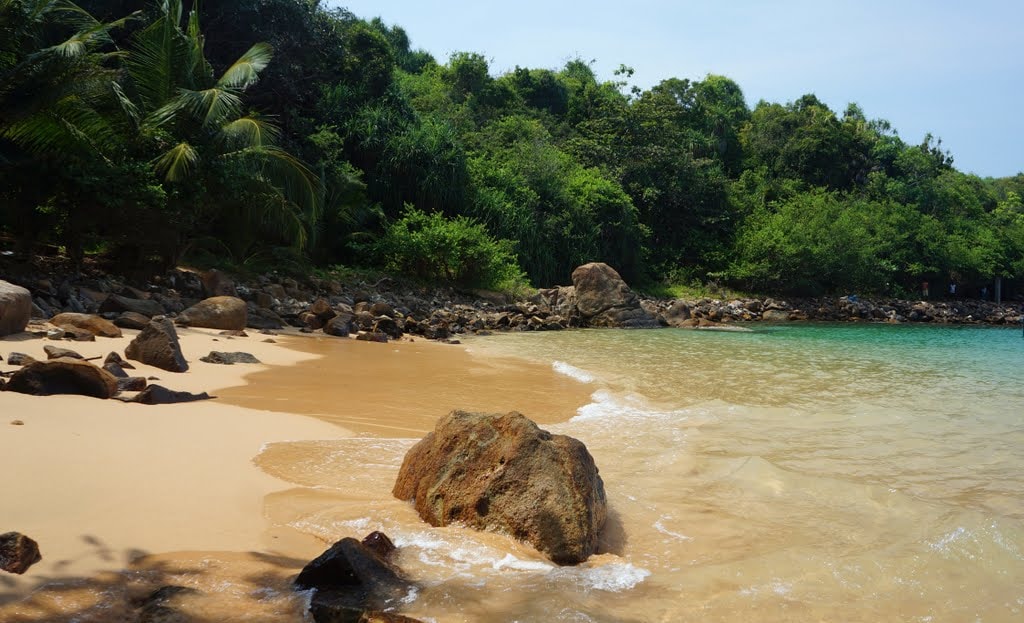
The beach gets its name from the dense tropical forest that surrounds it.
Jungle Beach is surrounded by dense tropical vegetation that comes right down to the water’s edge, creating a sense of isolation and tranquillity. The beach’s small size and hidden location mean it’s rarely crowded, providing an intimate experience with nature.
The calm, clear waters make it ideal for swimming and snorkelling. The nearby coral reefs support diverse marine life, including tropical fish, sea turtles, and various coral species. The beach’s protected location creates calm conditions most of the year.
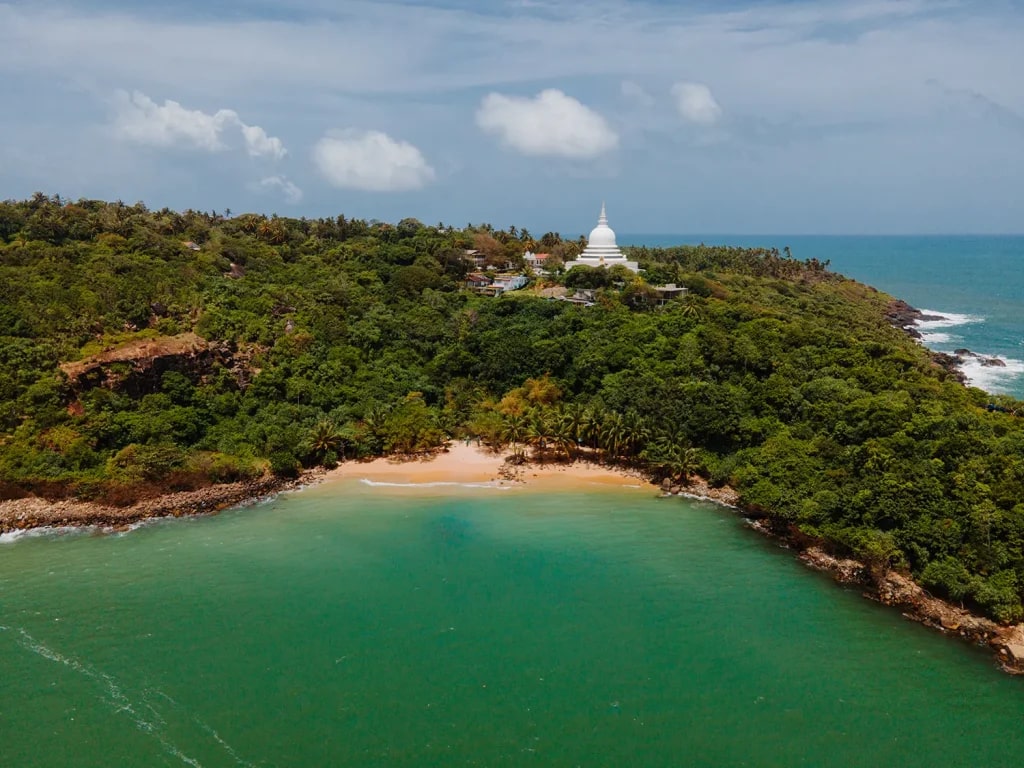
It’s generally less crowded than major tourist beaches like Mirissa or Hikkaduwa, offering a peaceful escape.
Local vendors occasionally visit the beach, offering fresh coconut water, tropical fruits, and simple snacks. The informal service adds to the authentic experience whilst providing refreshments for visitors who spend the day at this hidden gem.
The beach’s orientation provides good light for photography throughout the day, with the surrounding forest creating natural frames for photos. The contrast between the golden sand, blue water, and green vegetation creates stunning visual compositions.
Day 19-20: Negombo Beach – Coastal Culture and Airport Proximity
Conclude your journey in Negombo, conveniently located just 15 minutes from Bandaranaike International Airport. This coastal town offers a perfect blend of relaxation and cultural experiences, making it an ideal final destination before departure.
Negombo has been an important fishing centre for centuries, and this heritage remains central to the town’s character. The fishing industry continues to provide livelihoods for many local families, and visitors can observe traditional fishing methods alongside modern techniques.
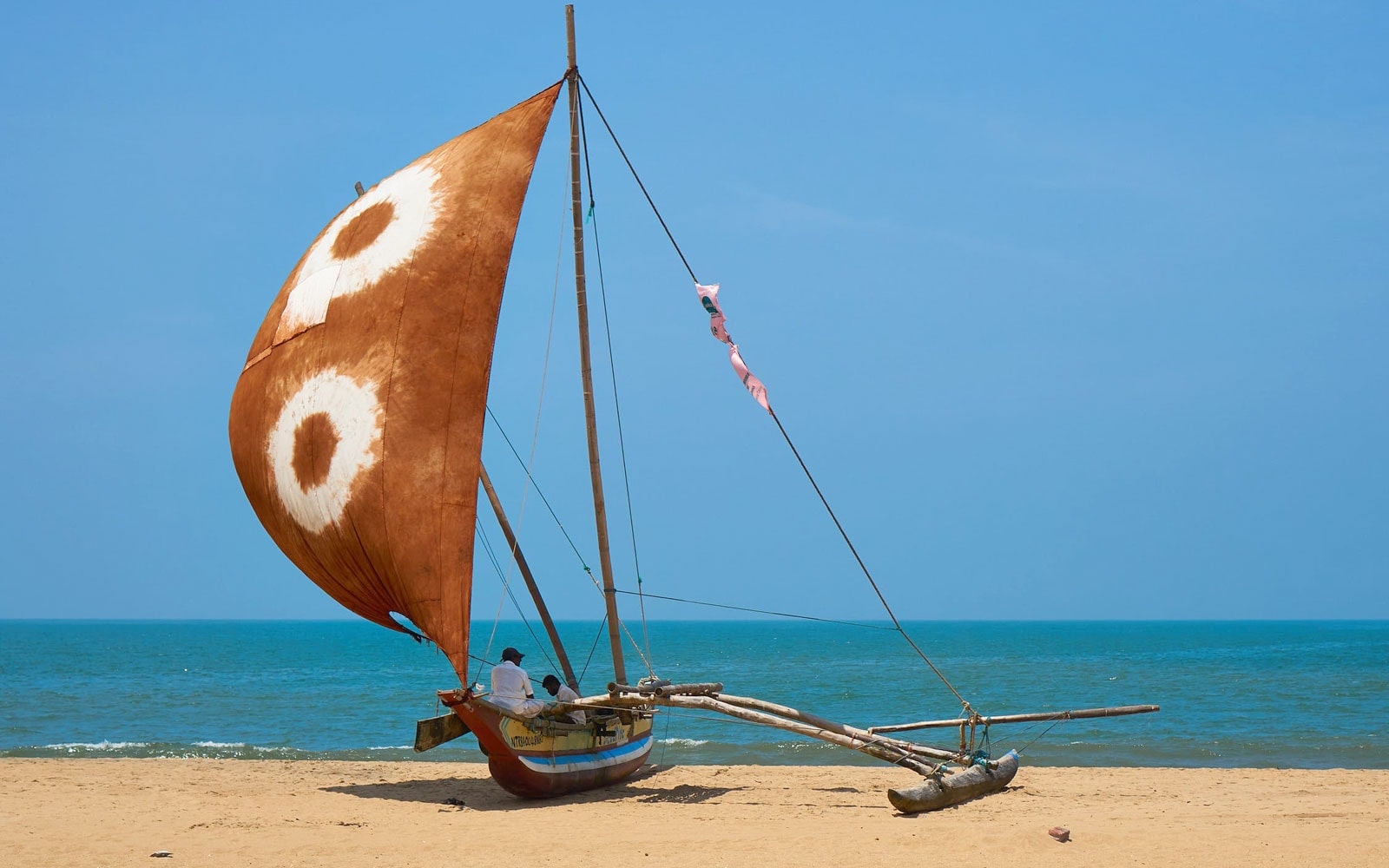
Negombo Beach features a long stretch of golden sand.
Explore the bustling fish market, one of the largest in Sri Lanka, where fishermen bring in their daily catch. The market operates early in the morning when the fishing boats return with their overnight catch. The variety of fish, from small anchovies to large tuna, demonstrates the richness of the Indian Ocean waters.
The market provides fascinating insights into local life and the importance of fishing to coastal communities. Vendors sell fish to retailers, restaurants, and local families, creating a vibrant atmosphere of commerce and social interaction. The market’s location along the beach means visitors can watch fishing boats being launched and returned throughout the day.
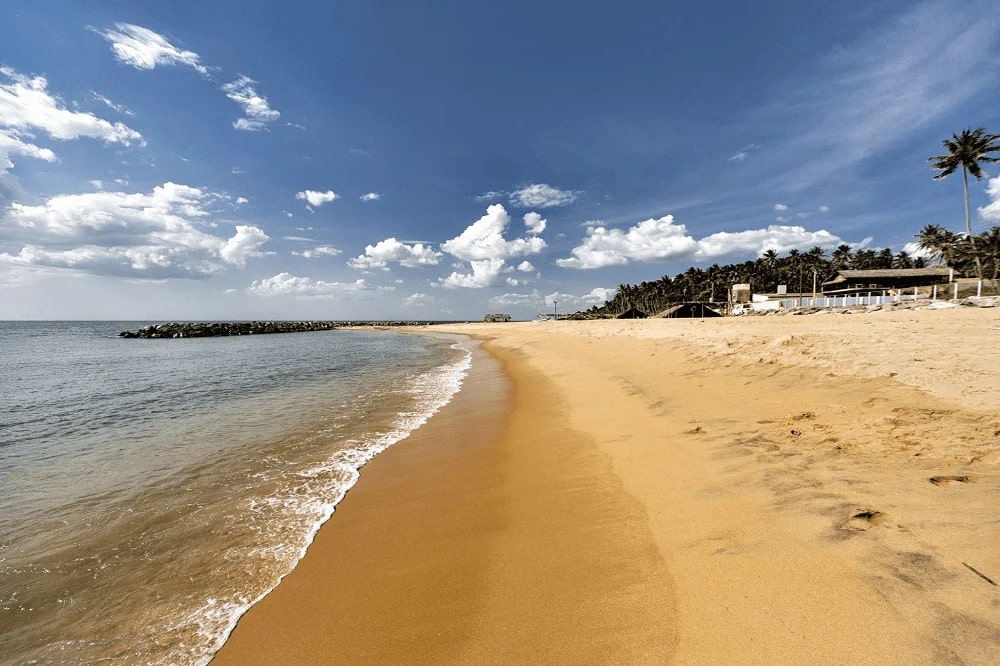
It’s a popular spot for sunbathing and enjoying a relaxed beachside atmosphere.
Visit St. Mary’s Church, one of the largest churches in Sri Lanka, showcasing the Portuguese colonial influence on the island’s architecture and religion. The church, built in 1874, features neo-classical architecture and beautiful stained glass windows. The church’s size and grandeur reflect the importance of Negombo’s Catholic community, which traces its roots to Portuguese colonial times.
The church’s interior contains beautiful artwork and religious artifacts, whilst the peaceful atmosphere provides a quiet retreat from the bustling town. The church continues to serve the local community and hosts regular services that visitors are welcome to attend.
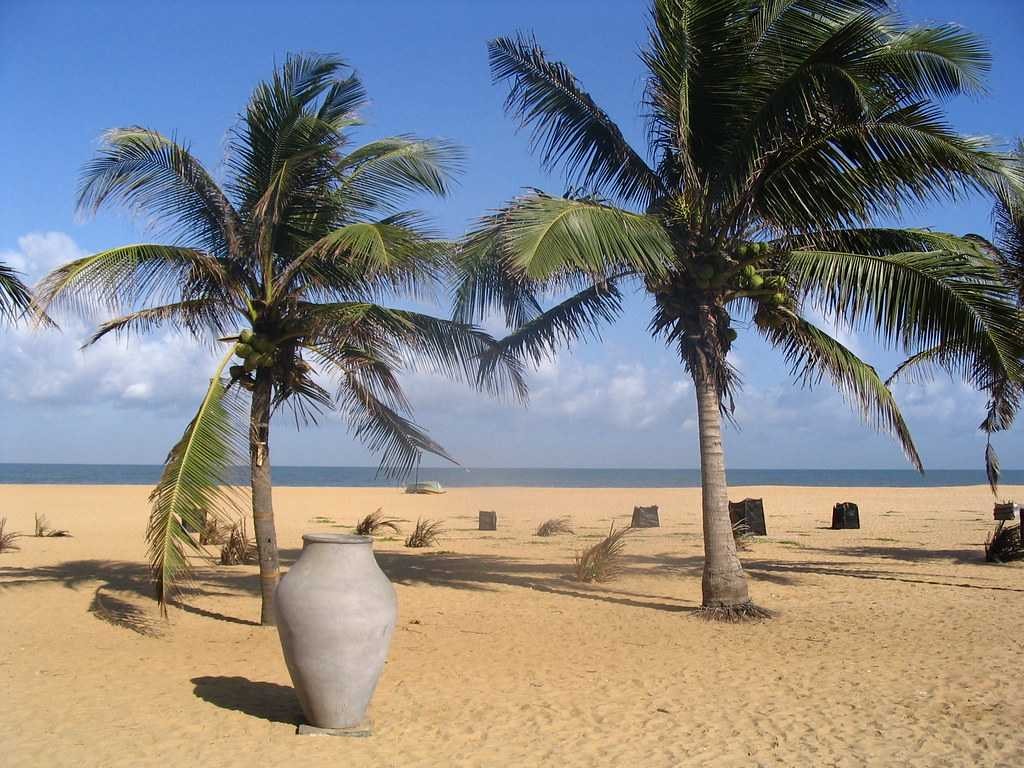
Negombo is renowned for its fresh seafood delicacies, including crab, prawns, and various fish dishes.
Take a boat trip through the Negombo Lagoon, observing local fishing techniques and mangrove ecosystems. The lagoon, which connects to the sea through a narrow channel, supports diverse ecosystems and provides livelihoods for local fishing communities.
The boat trips typically last 2-3 hours and include visits to traditional fishing villages, mangrove forests, and bird watching areas. The lagoon supports numerous bird species, including herons, egrets, kingfishers, and various waterfowl. The mangrove forests provide nursery areas for fish and protect the coastline from erosion.
Local guides explain traditional fishing methods, including the use of outrigger canoes and traditional nets. The trips often include stops at villages where visitors can observe daily life and traditional crafts such as boat building and net making.
Northern Sri Lanka: Extended Adventure Options
Jaffna Peninsula – Cultural Diversity
For travellers with additional time, the northern region of Sri Lanka offers unique cultural experiences and historical insights. Jaffna, the largest city in northern Sri Lanka, showcases Tamil culture and provides perspectives on the island’s ethnic diversity.
The Jaffna Peninsula features distinct architecture, cuisine, and cultural traditions that reflect its Tamil heritage. The region’s temples, particularly the Nallur Kandaswamy Temple, showcase Dravidian architecture and Hindu traditions that differ from the predominantly Buddhist sites in other parts of the island.
The area’s history includes ancient kingdoms, colonial influences, and more recent conflicts that have shaped the region’s character. Restoration efforts have rebuilt many damaged sites, and the region is experiencing renewed development and tourism growth.
Anuradhapura – Ancient Capital
Anuradhapura, one of Sri Lanka’s ancient capitals and a UNESCO World Heritage Site, offers insights into the island’s early Buddhist civilisation. The city served as the capital for over 1,000 years and contains some of the most important Buddhist sites in the world.
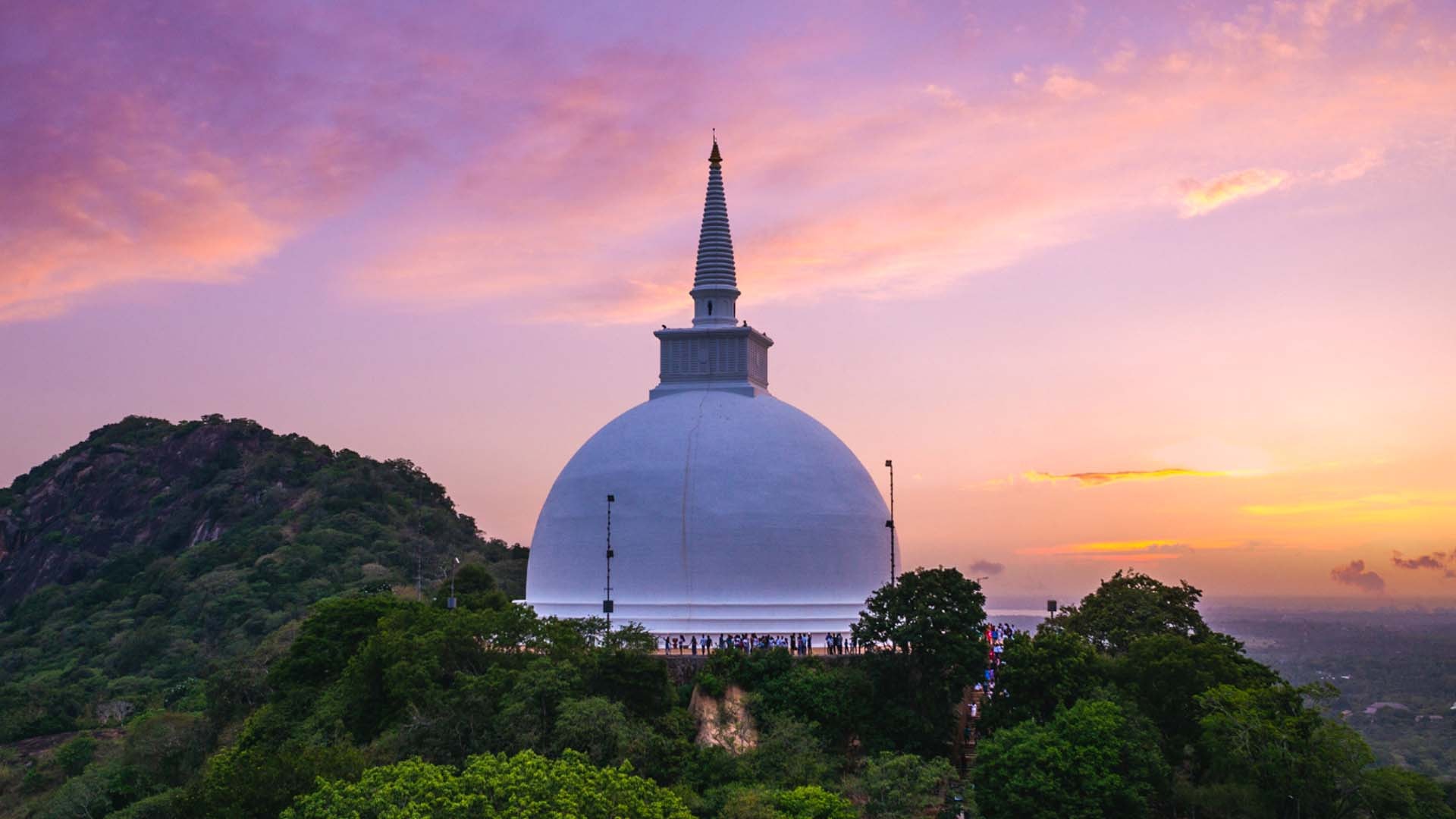
A treasure trove of ancient sculptures, including the famous carving of “The Lovers”.
The sacred Bo tree (Sri Maha Bodhi), grown from a cutting of the tree under which Buddha attained enlightenment, is over 2,000 years old and attracts pilgrims from around the world. The ancient stupas, including Ruwanwelisaya and Jetavanaramaya, are among the largest brick structures in the world.
The ancient city’s sophisticated hydraulic engineering, including reservoirs and irrigation systems, demonstrates the advanced knowledge of early Sri Lankan civilisation. Many of these systems continue to function today, providing water for agriculture and communities.
Wildlife and Nature Beyond the Classics
Minneriya National Park – The Gathering
Minneriya National Park offers one of Sri Lanka’s most spectacular wildlife experiences during the dry season (July to October) when hundreds of elephants gather around the Minneriya Reservoir. This phenomenon, known as “The Gathering,” represents the largest congregation of Asian elephants in the world.
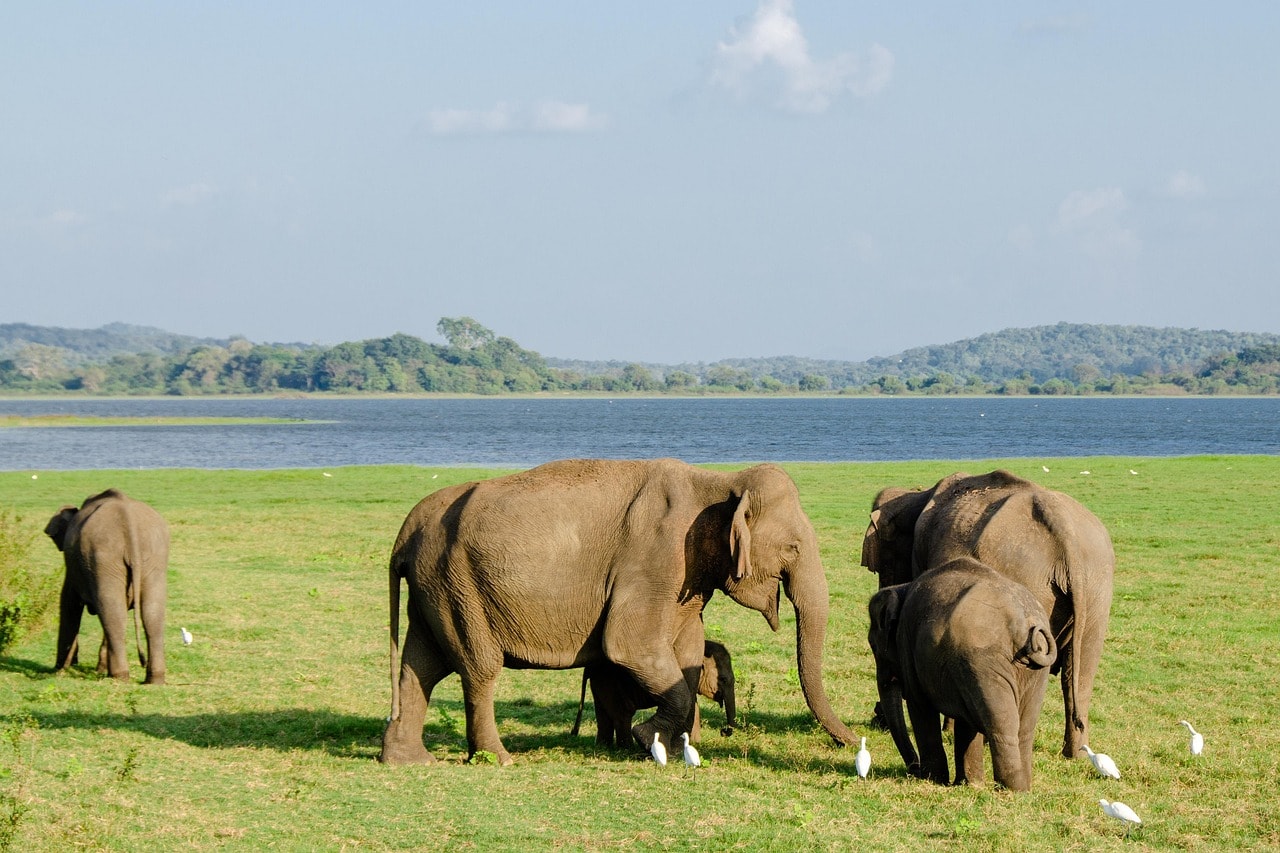
The best period to witness the “Gathering” is during the dry seaso.
The park’s relatively small size (8,889 hectares) means wildlife viewing is concentrated around the reservoir area. Besides elephants, the park supports leopards, sloth bears, and over 160 bird species. The park’s mix of dry woodland and grassland creates diverse habitats within a compact area.
Horton Plains National Park – World’s End
Horton Plains National Park, located in the central highlands, offers unique montane ecosystems and spectacular viewpoints. The park’s most famous attraction is World’s End, a dramatic cliff that drops 870 metres to the plains below.
The park’s high altitude (above 2,000 metres) creates cool temperatures and unique vegetation, including cloud forests and grasslands. The park is home to several endemic species, including the Sri Lankan whistling thrush and the Horton Plains slender loris.
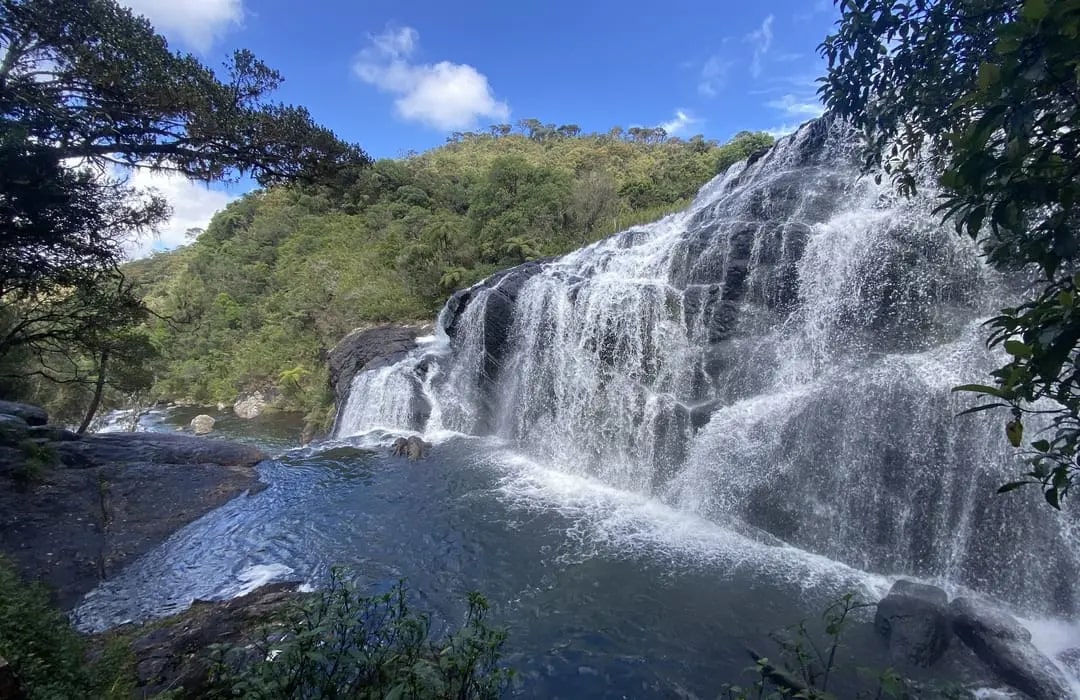
Horton Plains is known for being the coldest and one of the windiest locations in Sri Lanka.
The hiking trail to World’s End is approximately 9 kilometres and takes 3-4 hours to complete. Early morning visits are essential, as clouds typically obscure the view after 10:00 AM. The trail passes through diverse ecosystems and offers excellent bird watching opportunities.
Baker’s Falls, a 20-metre waterfall within the park, provides a scenic stop along the hiking trail. The falls are named after Sir Samuel Baker, a British explorer who mapped much of the region during the colonial period.
Wilpattu National Park – Leopard Country
Wilpattu National Park, Sri Lanka’s largest national park, covers 1,317 square kilometres and offers excellent leopard spotting opportunities with fewer crowds than other parks. The park’s name means “Land of Lakes” in Sinhala, referring to the numerous natural lakes (villus) that dot the landscape.
The park’s diverse ecosystems include dry woodland, grasslands, and wetlands that support a wide variety of wildlife. Besides leopards, the park is home to elephants, sloth bears, spotted deer, and over 30 species of mammals. The park’s remote location and size mean wildlife encounters often feel more authentic and less touristy.
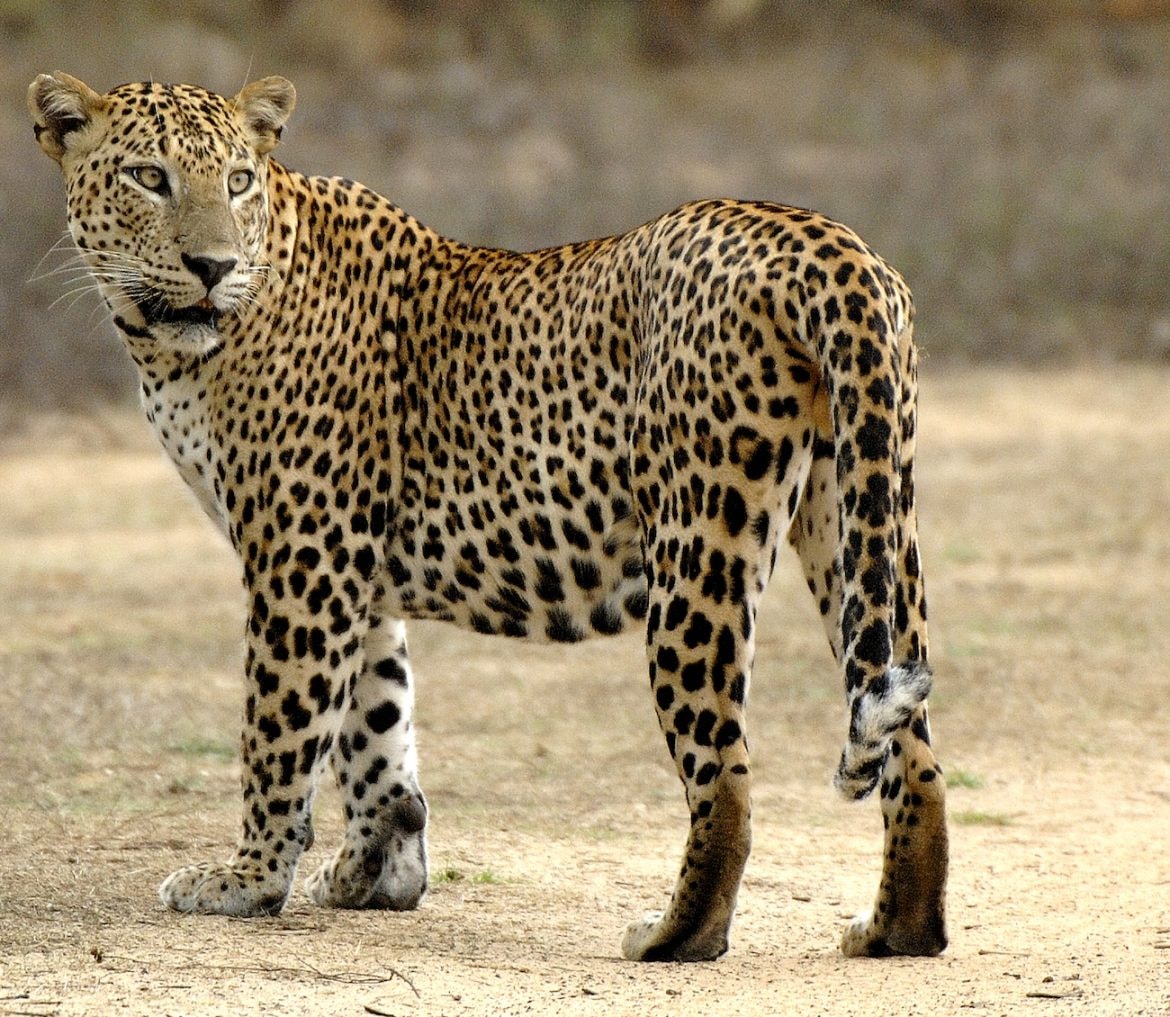
Wilpattu is considered one of the premier locations for spotting the elusive Sri Lankan leopard.
The park was closed for nearly two decades due to civil conflict but reopened in 2010. The extended closure allowed wildlife populations to recover, and the park now offers some of the best wildlife viewing in Sri Lanka. The park’s numerous lakes attract wildlife throughout the year, making it excellent for game viewing in all seasons.
East Coast Adventures
Trincomalee – Ancient Port and Pristine Beaches
The east coast of Sri Lanka offers a different perspective on the island’s coastal beauty, with pristine beaches, ancient history, and excellent diving opportunities. Trincomalee, one of the world’s finest natural harbours, has been an important port for over 2,000 years.
The city’s strategic location made it a coveted prize for various powers throughout history, including the Portuguese, Dutch, and British. The remnants of Fort Frederick, built by the Portuguese and later expanded by the Dutch and British, overlook the harbour and provide insights into the city’s colonial past.
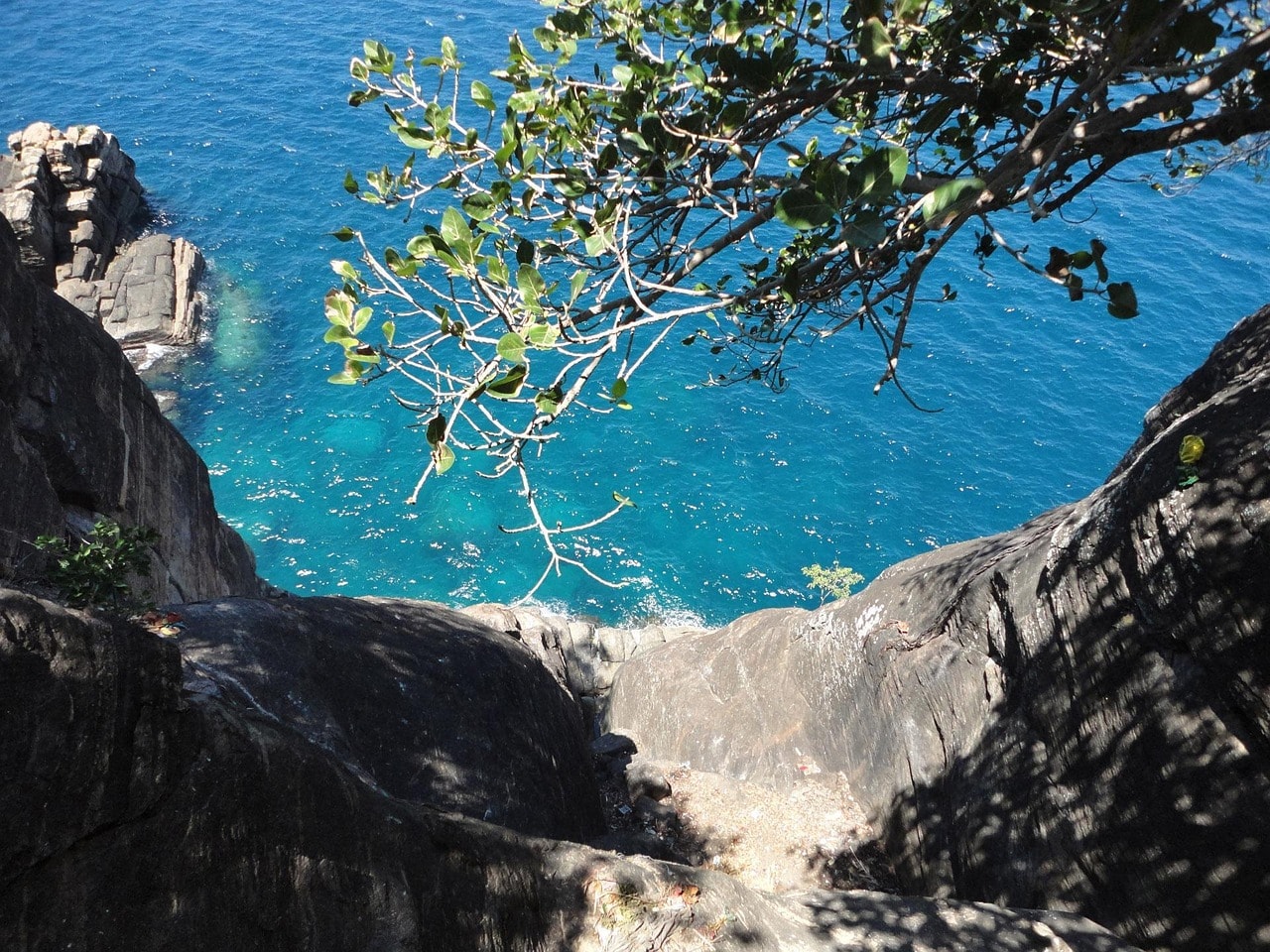
Trincomalee boasts one of the world’s finest and largest natural deep-water harbors.
The east coast’s beaches, including Uppuveli and Nilaveli, offer pristine white sand and crystal-clear waters. These beaches are less developed than their western counterparts, providing a more tranquil and authentic beach time. The calm waters and coral reefs make them excellent for swimming, snorkelling, and diving.
Arugam Bay – Surfing Paradise
Arugam Bay, on the southeastern coast, is Sri Lanka’s premier surfing destination and attracts surfers from around the world. The bay’s consistent waves and laid-back atmosphere create a perfect environment for both experienced surfers and beginners.
The main surf season runs from April to October, coinciding with the east coast’s dry season. The bay offers several surf breaks suitable for different skill levels, from gentle waves for beginners to challenging breaks for experienced surfers.
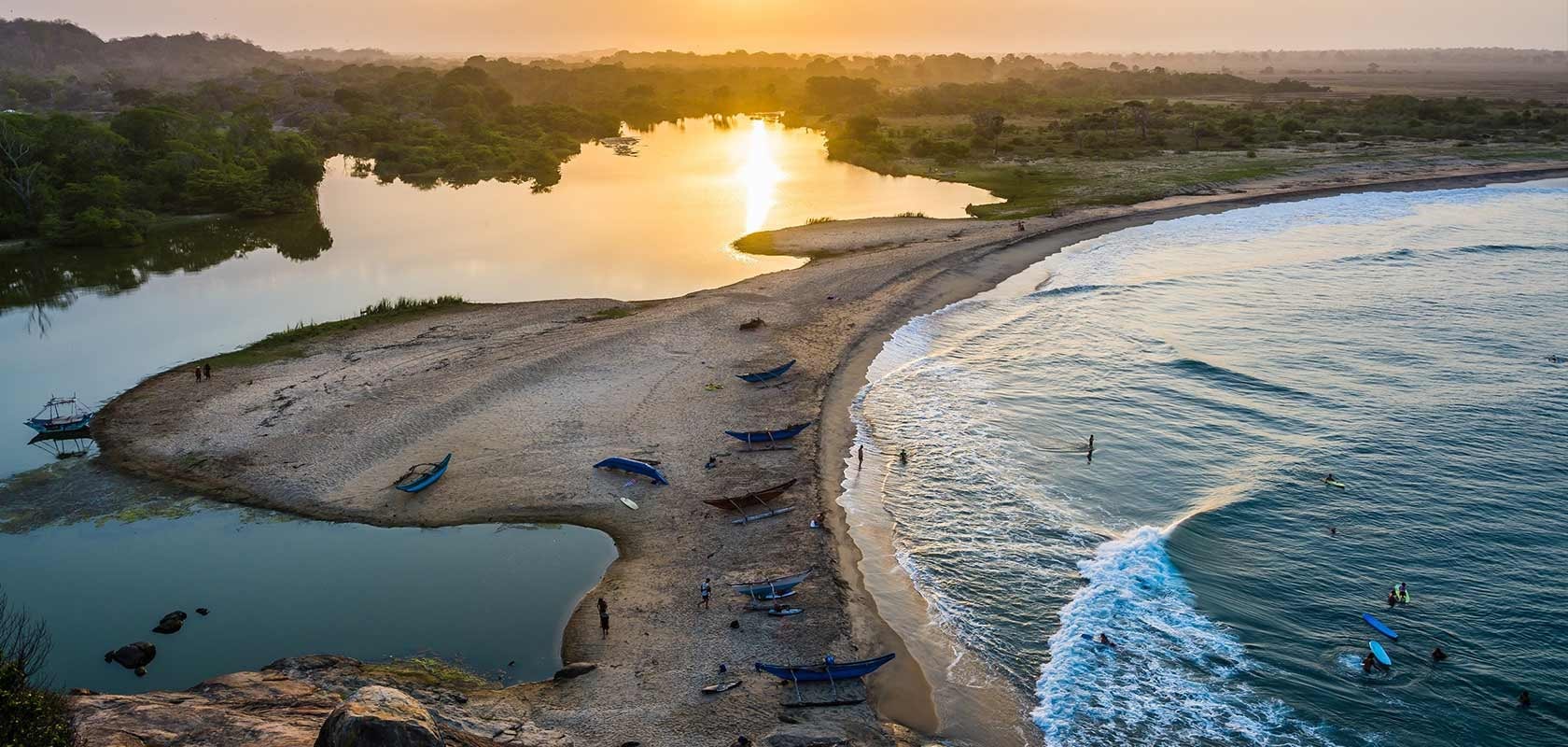
Most popular and suitable for experienced surfers with powerful waves.
The town’s relaxed atmosphere and international surf community create a unique cultural blend. Local surf schools offer lessons and equipment rental, whilst beachside cafes serve everything from traditional Sri Lankan cuisine to international dishes catering to the diverse visitor population.
Tea Country Deep Dive
Nuwara Eliya – Little England
Nuwara Eliya, often called “Little England,” showcases the British colonial influence on Sri Lanka’s hill country. The town’s cool climate, colonial architecture, and manicured gardens create an atmosphere reminiscent of a Sri Lankan countryside town.
The town sits at an elevation of 1,868 metres, creating a temperate climate that provided relief for British colonists from the tropical heat. The colonial buildings, including the Grand Hotel and Hill Club, maintain their original character and provide insights into colonial life.
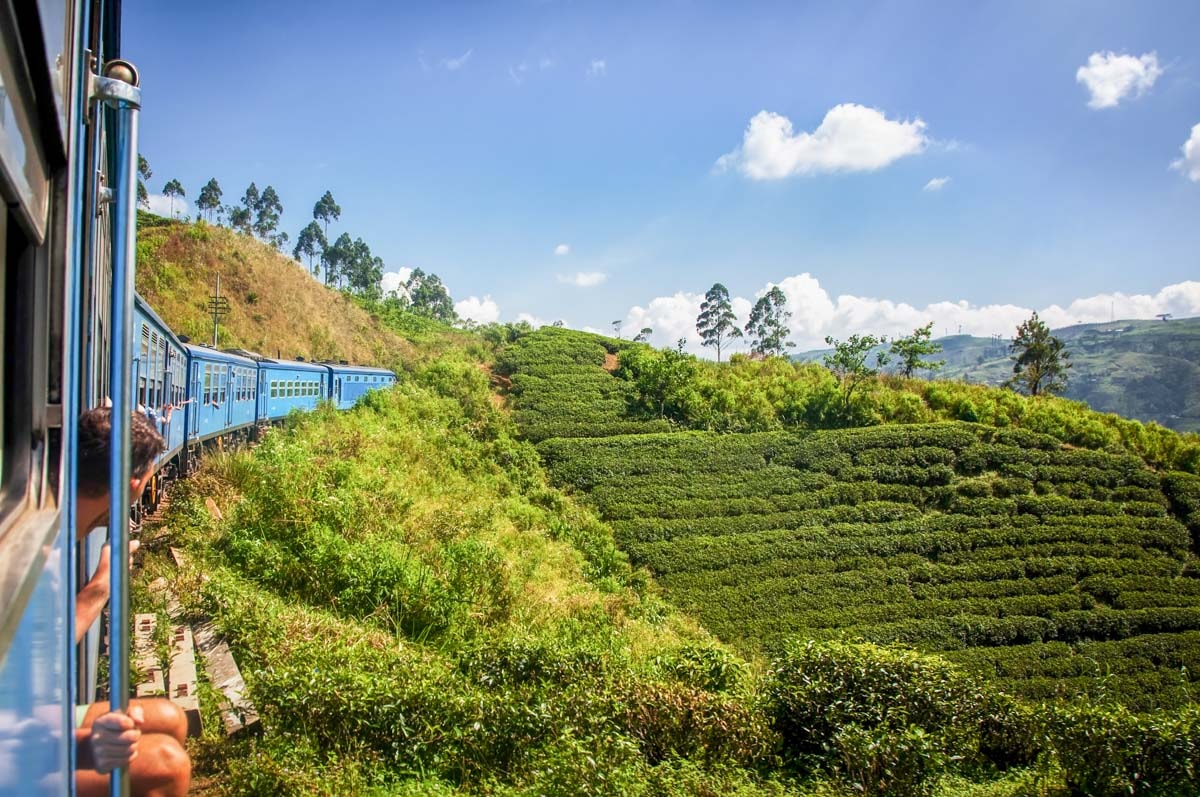
The region is characterized by rolling green hills, misty mornings, and vast tea plantations that carpet the slopes.
The town’s golf course, established in 1889, is one of the oldest in Asia and continues to attract golfers from around the world. The course’s challenging layout and scenic mountain views make it a unique golfing experience.
Lake Gregory, an artificial lake created during the British period, provides opportunities for boating and peaceful walks. The lake’s perimeter path offers views of the surrounding mountains and colonial buildings.
Pedro Tea Estate – From Bush to Cup
Visit the Pedro Tea Estate, one of Sri Lanka’s highest tea plantations, to understand the complete tea production process. The estate, located at an elevation of over 1,800 metres, produces some of the world’s finest high-altitude teas.
The tour begins in the tea fields, where visitors can observe tea pluckers harvesting the tender leaves. The skilled workers, predominantly women, can pick up to 20 kilograms of tea leaves per day. The two leaves and a bud harvesting method ensures the highest quality tea.
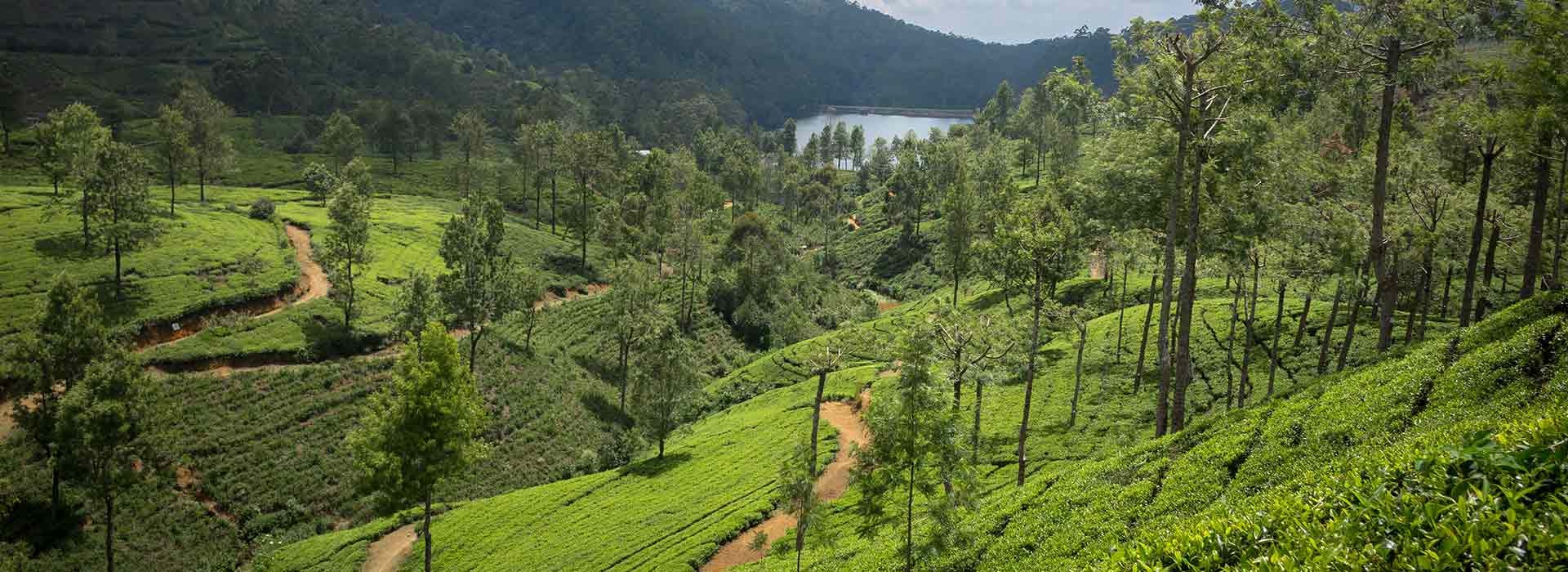
The estate produces famous black tea brands like Lovers Leap and Mahagastotte.
The tasting session allows visitors to sample different grades of tea and understand the factors that affect flavour, including elevation, processing methods, and seasonal variations. The estate’s shop offers opportunities to purchase fresh tea directly from the source.
Practical Tips for Your Sri Lanka Adventure
Transportation
Hiring a private driver provides flexibility and comfort for exploring the island. Many drivers are knowledgeable about local attractions and can serve as informal guides.
For budget travellers, public buses connect all major destinations, though they can be crowded and slow. The railway system offers a more comfortable alternative for longer journeys.
Accommodation Options
Sri Lanka offers accommodation ranging from budget guesthouses to luxury resorts. Mid-range hotels provide excellent value, often including breakfast and airport transfers.
Consider staying in boutique hotels within heritage buildings for a unique experience. Many former colonial mansions have been converted into charming accommodations.
Food and Dining
Sri Lankan cuisine reflects the island’s multicultural heritage, incorporating Indian, Malay, Dutch, and Portuguese influences. Rice and curry form the staple meal, typically served with various accompaniments.
Try traditional dishes like hoppers (bowl-shaped pancakes), kottu roti (chopped flatbread stir-fry), and fresh seafood curries. Most restaurants can adjust spice levels for international palates.
Health and Safety
Ensure routine vaccinations are up to date and consider additional vaccines for hepatitis A and typhoid. Use insect repellent to prevent mosquito-borne diseases.
Drink bottled water and be cautious with street food, especially during your first few days as your system adjusts to local cuisine.
Cultural Sensitivity
Sri Lanka is predominantly Buddhist, so dress modestly when visiting temples. Remove shoes and hats before entering sacred areas, and avoid pointing feet towards Buddha statues.
Photography may be restricted in some religious sites, so always ask permission before taking pictures.
Don’t Miss Our Exclusive Offers! Subscribe Today!
For the ultimate travel inspiration, local insight straight from our expert Local Designers and exclusive offers you won’t find anywhere else from Designer Journeys, sign up today! Don’t miss out.
A three-week journey through Sri Lanka provides an incredible diversity of experiences within a relatively compact area. From the cultural richness of ancient cities to the natural beauty of national parks, from the colonial charm of coastal towns to the tranquil beauty of hill country tea plantations, the island offers something for every type of traveller.
The warmth and hospitality of the Sri Lankan people enhance every experience, making visitors feel welcomed and valued. Whether you’re seeking adventure, cultural immersion, wildlife encounters, or simply relaxation on pristine beaches, Sri Lanka delivers beyond expectations.
The island’s compact size means you can experience dramatic landscape changes within short distances, from tropical beaches to misty mountains, from ancient ruins to modern cities. This accessibility makes Sri Lanka an ideal destination for those seeking diverse experiences without extensive travel time.
